Special Edition WTM LONDON
Free distribution
November 2024


Special Edition WTM LONDON
Free distribution
November 2024

Embark on a journey through the beauties of Brazilian tourism

ATTRACTIONS
Beaches, waterfalls, museums, parks and many other possibilities await you from north to south
SPECIAL SUPPLEMENTS
Discover what makes the states of Ceará and Mato Grosso do Sul unmissable destinations for your next vacation



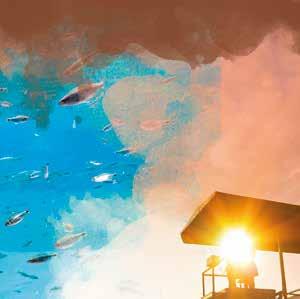
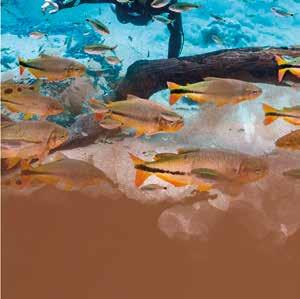





In the South Pantanal, the world's largest tropical wetland area, tourists will find century-old farms that o er various ecotourism activities, such as photo safaris, horseback ridings, bird watching, and experiencing the culture and routine of authentic country life, in addition to savoring the typical and delicious regional cuisine.
The tourist region Bonito-Serra da Bodoquena, the First Carbon Neutral Ecotourism Destination in the world and elected 17 times the best ecotourism destination in Brasil, guarantees exceptional moments for its visitors, such as mysterious caves, snorkeling in natural aquariums, bathing and diving in crystal clear waters and much, much more. Take your clients to see enchanting places all year round and take advantage of the low season to organize packages with attractive prices.






Provide authentic and unforgettable experiences in the tourism regions
Unique and true natural experiences
Singular culture of the Pantanalian inhabitants
Authentic regional gastronomy
Safe destinations with specialized tour guides
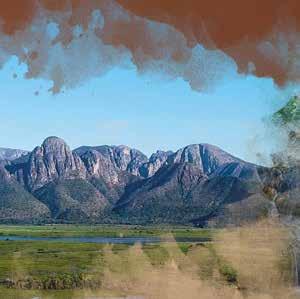



Ecotourism activities for the whole family
Flights under 2 hours from Congonhas Airport (São Paulo)
Hospitality embracing diversity






Did you know that Brazil, with its rich cultural and natural diversity, is becoming an increasingly attractive destination for international tourists? Between January and September 2024, the country saw a 12% increase in foreign visitors compared to the same period last year, welcoming a total of 4.897 million international travelers. These figures reflect Brazil’s continued growth and its irresistible appeal for those seeking new adventures.
In September alone, 445,389 foreign tourists arrived, marking a remarkable 26.4% increase over the previous year and underscoring Brazil’s rising popularity as a tourist hotspot. Visitors are drawn to the country’s breathtaking natural and cultural beauty.
One of Brazil’s main attractions is its stunning natural landscapes. From the iconic beaches of Copacabana and Ipanema in Rio de Janeiro to the vast Amazon rainforest, the country showcases a remarkable array of scenery. The breathtaking waterfalls of Chapada dos Veadeiros National Park and the pristine white sands of Lençóis Maranhenses National Park are just a few of the wonders that captivate visitors, offering unforgettable experiences.
In addition to its natural beauty, Brazil’s rich culture is a major draw for visitors. Cities like Salvador, Recife, and Ouro Preto provide a deep immersion in local history and traditions. The famous Carnival, with its vibrant colors and infectious rhythms, is a spectacle that attracts tourists from around the globe,
allowing them to experience the joy and hospitality of Brazil firsthand. Gastronomy is another highlight of Brazilian tourism. Iconic dishes such as feijoada, acarajé, and moqueca tantalize the taste buds of travelers. Culinary experiences range from upscale restaurants to lively street markets, where you can savor authentic delicacies and explore regional cuisine. This variety makes Brazil an unmissable destination for food lovers.
For travelers from England, Brazilian hospitality is a key factor that should not be underestimated. The warmth and friendliness of the Brazilian people create a welcoming atmosphere, fostering new friendships and memorable experiences. This human connection is one of the aspects that most delights visitors and keeps them coming back for more.
Additionally, Brazil’s tourist infrastructure is continuously improving, making it easier for visitors to navigate the country. With new international flights and enhancements in transportation, even remote destinations are becoming more accessible. This evolution enhances the travel experience, ensuring that every moment in Brazil is enjoyable and safe.
With ongoing growth and recordbreaking tourism numbers, Brazil is positioning itself as a destination that not only promises unforgettable experiences but delivers them. So, if you’re planning your next trip, Brazil is waiting with open arms, ready to showcase its beauty and charm. Come and explore!

President Roy Taylor Vice-President Rosa Masgrau rosamasgrau@mercadoeeventos.com.br(55-21) 2254-3543
Editorial Director Natália Strucchi natalia.strucchi@mercadoeeventos.com.br(55-21) 99164-2940
Editor Janaina Brito janaina.brito@mercadoeeventos.com.br (55-11) 98779-5732
Sales Director Mari Masgrau mari.masgrau@mercadoeeventos.com.br(55-11) 97509-0605
Administrative and Financial Director Roberta Saavedra roberta.saavedra@mercadoeeventos.com.br(55-21) 2487-1616
Operational Andreia Boccalini andreia.boccalini@mercadoeeventos.com.br(55-11) 95389-7662
Reportage Ana Azevedo ana.azevedo@mercadoeeventos.com.br Rafael Torres rafael.torres@mercadoeeventos.com.br Bruno Renzi bruno.renzi@mercadoeeventos.com.br Beatriz do Vale beatriz.vale@mercadoeeventos.com.br Manuela Miniguini manuela.miniguini@mercadoeeventos.com.br
Photography Eric Ribeiro eric.ribeiro@mercadoeeventos.com.br
Designer Patrick Peixoto
Social Media Matheus Bueno
Reportage SP (55-11) 97863-2020 | Reportage RJ (55-21) 99164-2940
Reader Service (55-11) 95389-7662
IT Infrastructure Management WorkNet Tecnologia fernando.carilo@worknetecnologia.com.br
WA Agency
Agência WA (https://waagenciadigital.com.br)
Sales Departament (55-11) 95389-7662
Rua 24 de Maio, 276 - 3º andar - República, São Paulo - SP, 01041-000
Commercial Representative in the United States Juliana Costa juliana.costa@mercadoeeventos.com.br+1 (850) 225-9376
Published by Editora Mercado e Eventos Ltda
The articles and opinions of third parties published in the issue do not necessarily reflect the position of the newspaper.

GENERAL INFORMATIONS
DISCOVER BRAZIL - 23
BRAZIL OVERVIEW - 24
DISTRITO FEDERAL - 46
MATO GROSSO DO SUL - 48
RIO DE JANEIRO - 50
CELSO SABINO (MTUR) - 25
MARCELO FREIXO (EMBRATUR) - 28
BRUNO REIS (EMBRATUR) - 29
NORTHEAST
ALAGOAS - 30
PERNAMBUCO - 34
RIO GRANDE DO NORTE - 36
MARANHÃO - 38
CEARÁ - 40
NORTH INTERVIEWS
AMAZONAS - 42
PARÁ - 44
SÃO PAULO - 52
MINAS GERAIS - 54
PARANÁ - 56
SANTA CATARINA - 58
RIO GRANDE DO SUL - 60
SPECIAL SUPPLEMENTS
CEARÁ - 7
MATO GROSSO DO SUL - 15
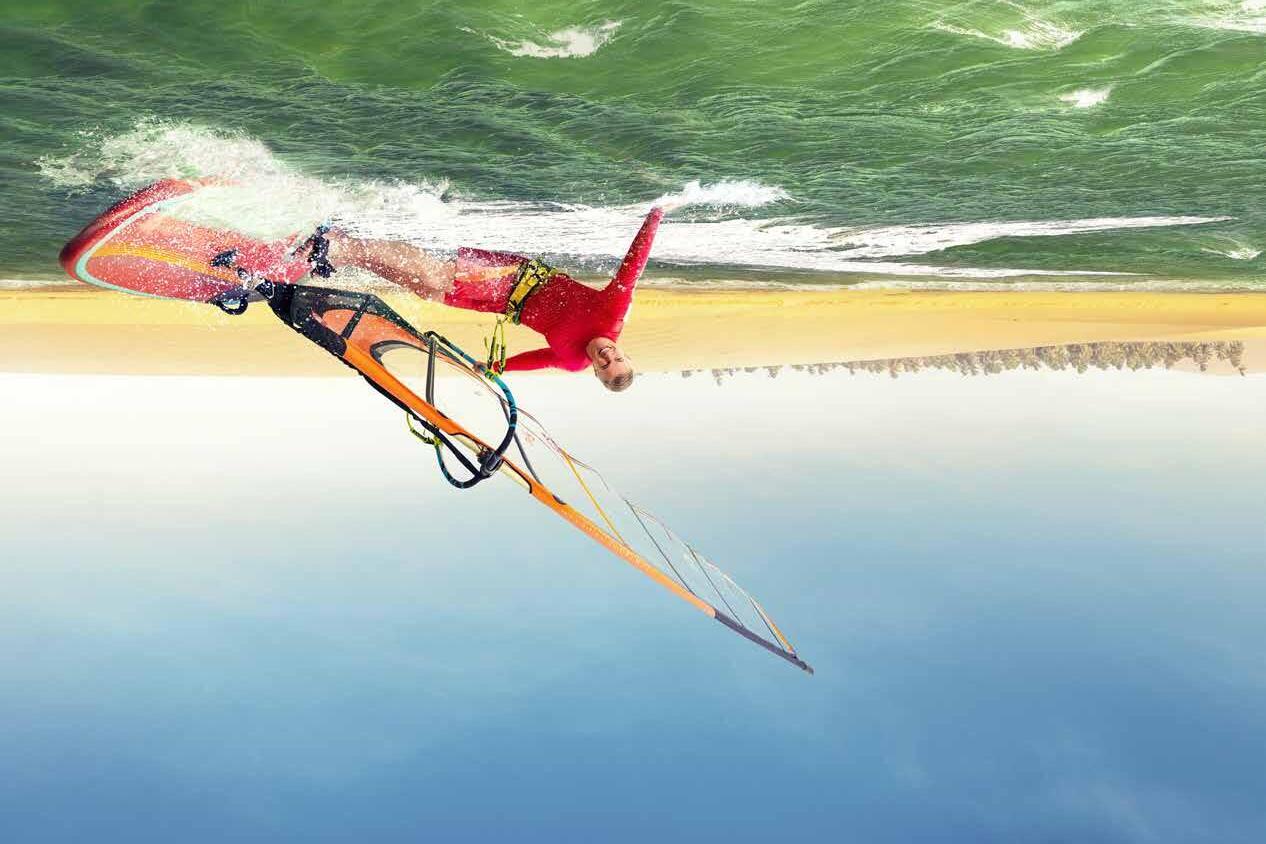
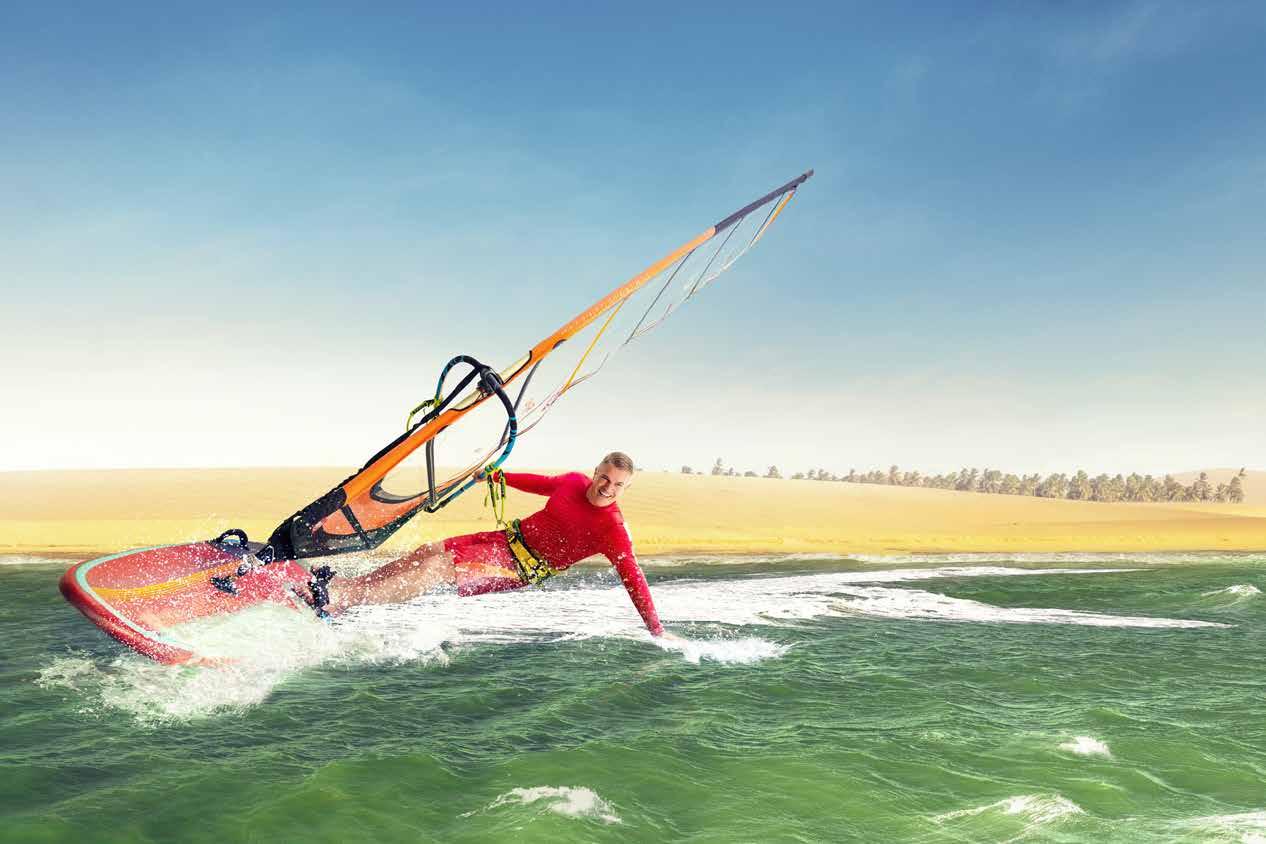

For more information, point your phone’s camera at the QR Code next to it and follow us on social media.
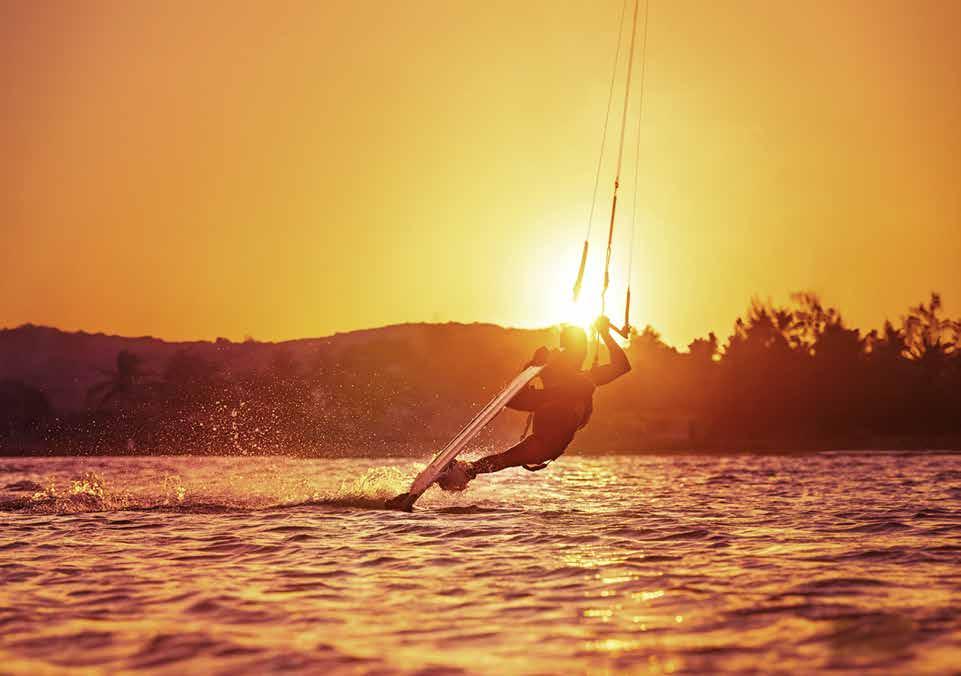
Nestled in the municipality of Caucaia, Cumbuco Beach is a true paradise for those looking to unwind in stunning surroundings. The perfect blend of lush nature and tourist amenities makes this destination ideal for creating unforgettable memories.
With its steady winds and tranquil lagoons, Cumbuco is a haven for kitesurfers, undeniably its main attraction and one of the best spots in the world for the sport.
It’s no surprise that Cumbuco hosts numerous national and international kitesurfing competitions. For newcomers to the sport, there are several schools and experienced instructors offering lessons and equipment, ensuring fun for all skill levels.
Beyond the water, a variety of activities offer extra thrills and adventure. Tourists can enjoy exhilarating buggy rides through the dunes, with breathtaking sunsets illuminating the landscape in the late afternoon.
When it comes to dining, Cumbuco boasts an excellent selection of restaurants and beachside stalls. Upscale beach clubs enhance the experience, providing live music and a relaxed ambiance. Accommodation options range from charming, cozy inns to luxurious resorts, catering to those seeking comfort and exclusivity. With amenities like swimming pools and spas, visitors are guaranteed a complete and rejuvenating stay.
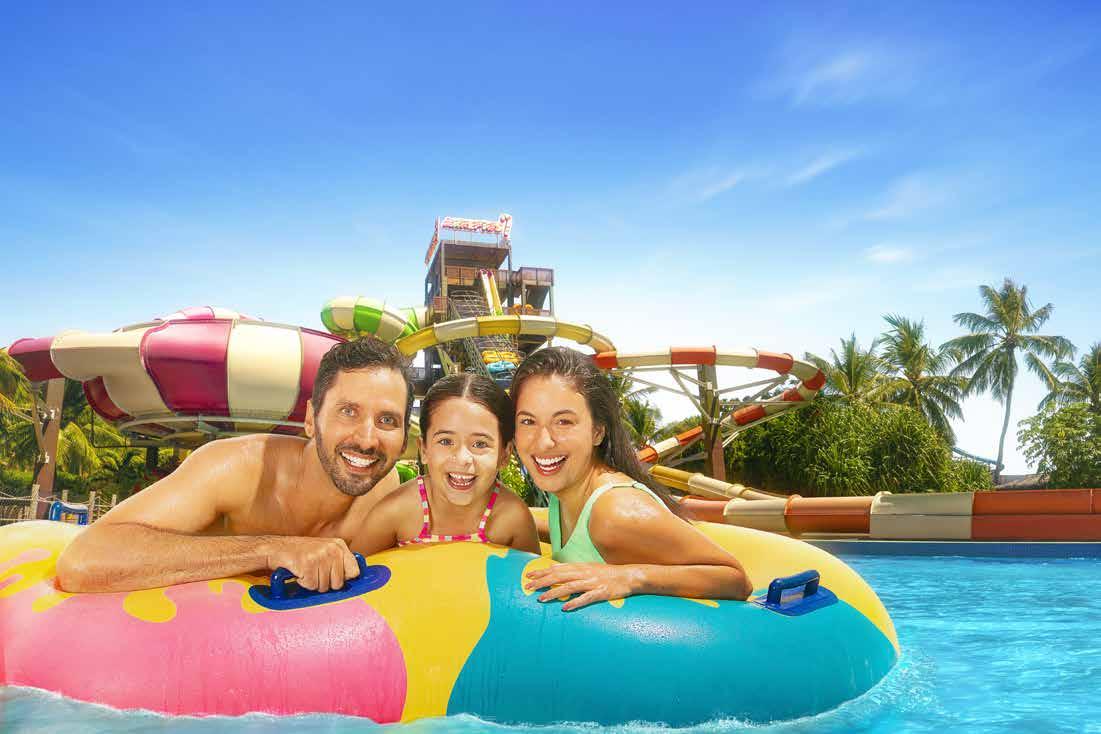
With a rich blend of history, culture, and countless leisure options, Aquiraz—the first city in the state—is a must-visit destination, especially for families. Home to Beach Park, one of the largest water parks in Latin America, this vibrant locale features wave pools, thrilling waterslides, and themed areas for all ages, making it synonymous with adventure and entertainment. The park also boasts a complete range of services, including resorts, restaurants, and shops, ensuring comfort and fun for every visitor.
The beaches of Aquiraz are attractions in their own right. Porto das Dunas and Prainha are perfect for those looking to relax by the sea, engage in water sports, or simply admire the stunning beauty of the Ceará coastline. Prainha, in particular, is famous for its beach huts, which offer spectacular views of the ocean.
The city also cherishes a rich historical and cultural heritage. A highlight is the São José de Ribamar Sacred Museum, which houses a collection dating back to colonial times and showcases the region’s religious traditions.
Whether you're seeking an exhilarating day at Beach Park, exploring breathtaking beaches, or savoring authentic local cuisine, Aquiraz promises unforgettable moments for anyone looking for a haven of fun and relaxation in Ceará.
A captivating destination
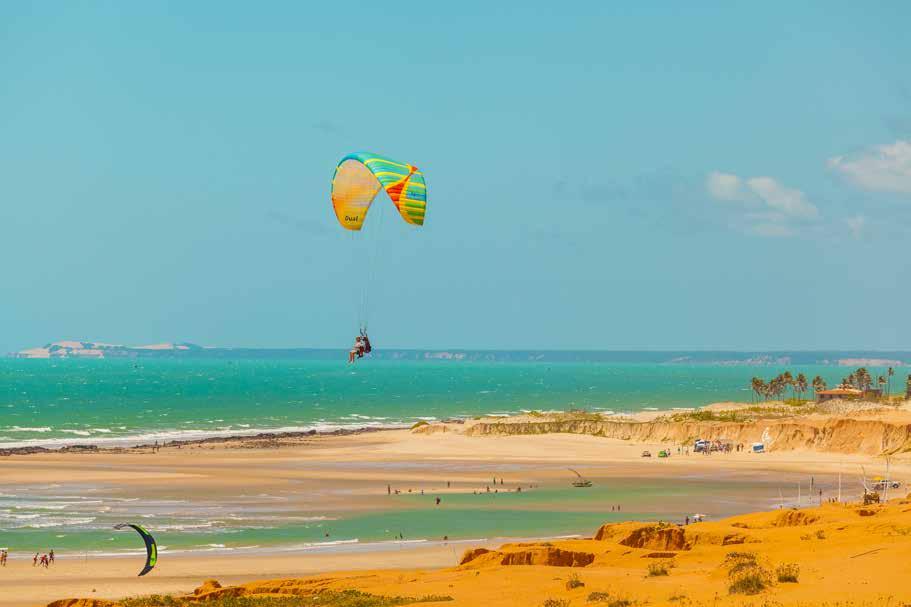
With its striking reddish cliffs, turquoise sea, and welcoming atmosphere, Canoa Quebrada offers a wealth of activities for visitors. The constant breeze that sweeps across the beach makes it a prime spot for paragliding, allowing adventurers to enjoy breathtaking views of the stunning landscape below.
Like other destinations in Ceará, Canoa Quebrada’s gastronomy is a major highlight. The town features a variety of restaurants serving local delicacies, such as fish moqueca and the renowned lobster, prepared in an array of mouthwatering styles. At night, the iconic Broadway Avenue comes alive with a vibrant mix of entertainment, featuring everything from traditional forró to contemporary rhythms.
A short distance away, the town of Aracati hosts one of Brazil's largest carnivals every February, blending performances by national artists with the rich local culture. The lively blocos that parade through the historic streets infuse the celebration with the joy of maracatu and other traditional festivities, while samba school performances add to the excitement.
Canoa Quebrada is more than just a beach; it’s a destination that harmoniously blends natural beauty, a laid-back vibe, and infectious energy. Whether you seek adventure in the waves, the unique flavors of local cuisine, or lively evenings filled with regional music, this destination promises unforgettable experiences for every type of traveler.


Beberibe captivates visitors with its stunning landscapes and unique natural formations. This municipality boasts some of the most iconic scenery along the Ceará coast, offering an ideal combination of adventure, culture, and leisure for those seeking unforgettable experiences.
Beaches like Morro Branco and Praia das Fontes are famous for their multicolored cliffs, creating veritable natural labyrinths. This breathtaking scenery is perfect for walking tours, allowing visitors to explore the intricate rock formations up close and admire the vibrant sands, which are even used to craft local handicrafts.
The Beberibe coastline is also a hotspot for kitesurfing and other water sports, attracting athletes of all skill levels. With perfect conditions for gliding through the waves, it offers a thrilling sense of freedom that enthusiasts cherish. Accommodation options are designed for comfort and tranquility, making it easy for visitors to unwind after a day full of adventure.
Beberibe seamlessly combines the beauty of natural landscapes with the excitement of sports and the flavors of local cuisine. Whether you're exploring the colorful cliffs, experiencing the adrenaline of water sports, or simply relaxing on its pristine beaches, Beberibe promises an unforgettable experience for all who visit.

Jericoacoara or simply “Jeri”, as it is affectionately called, is one of the most desirable destinations in Ceará, Brazil and even the world. The town, with its relaxed atmosphere, is surrounded by dunes, crystal-clear lagoons and stunningly beautiful beaches.
The sunsets are a spectacle in themselves. Every evening, tourists and locals gather to watch the sun set over the horizon, creating a magical and unforgettable scene. After this moment, the village comes alive with its charming bars and restaurants, which offer a diverse gastronomy, mixing local and international flavors.
Jeri is an enchanting destination that is home to some of Ceará's most famous tourist attractions, such as Pedra Furada, a rock formation sculpted by nature that has become a symbol of the region. Another highlight is the Lagoa Encantada, perfect for relaxing in underwater hammocks or practicing water sports such as kitesurfing.
This destination offers a unique experience, where natural beauty and local culture are in perfect harmony. Whether you want to glide through the waters on a kite, relax in a hammock over clear lagoons or explore the town's vibrant nightlife, Jeri is an invitation to experience unforgettable moments on the Ceará coast.
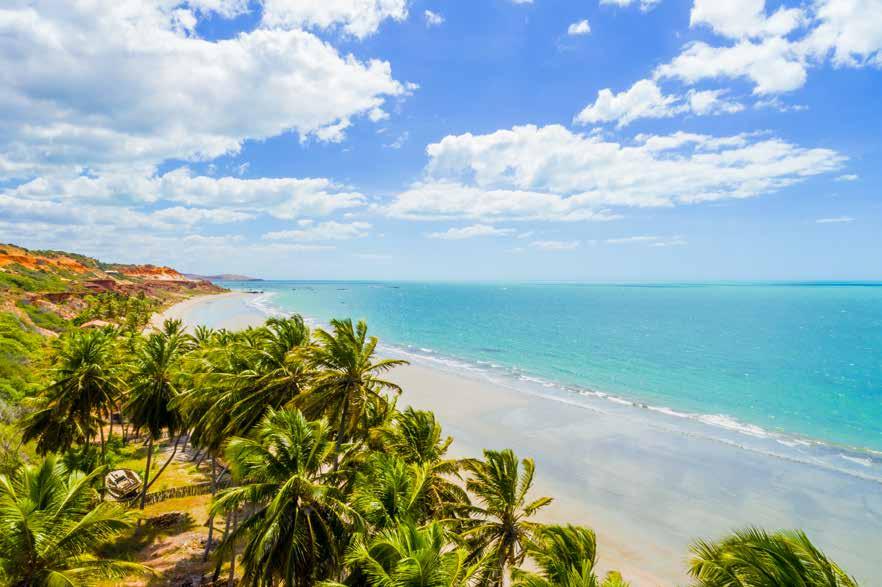
Icapuí is a coastal town renowned for its unspoiled beaches and warm, crystal-clear waters—perfect for those seeking an authentic, relaxing experience away from the crowds.
The coastline features breathtaking beaches such as Tremembé, Redonda, and Ponta Grossa, the latter being particularly iconic with its vibrant cliffs that beautifully contrast with the azure sea. These serene beaches are ideal for leisurely strolls, boat trips, and moments of contemplation, offering a true haven for nature lovers.
The gastronomy of Icapuí is rich in flavors, emphasizing the simplicity and freshness of local ingredients. At the region’s beach huts and restaurants, visitors can savor delicious meals accompanied by a gentle sea breeze.
Icapuí is the perfect destination for those looking to escape the hustle and bustle and connect with the essence of the Ceará coast. Whether you’re lounging on nearly deserted beaches, enjoying authentic seafood dishes, or exploring the lush surroundings, the city promises a unique and unforgettable experience for tourists in search of tranquility and natural beauty.
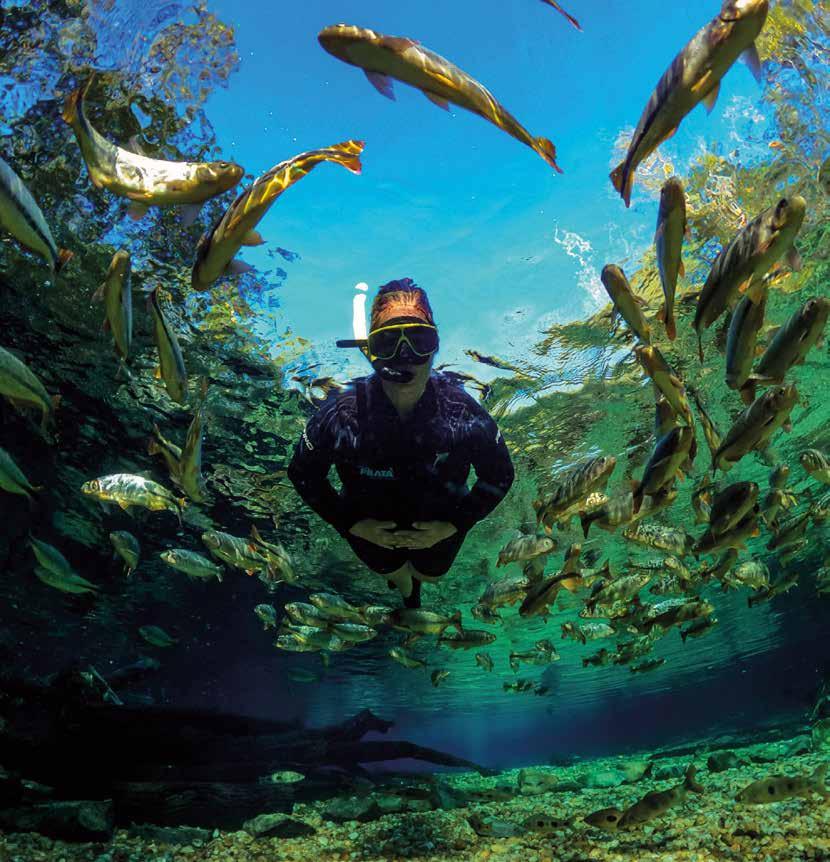
You can practice snorkeling in crystal-clear waters, cave diving, rappelling in a deep abyss or on a high platform, hiking on trails with waterfall baths, tubing, arborism, horseback riding, as well as observe our rich wildlife on day and night photo safaris both by
land and water. All this, and much more, is possible in Mato Grosso do Sul, which boasts globally recognized destinations like the Pantanal and Bonito/Serra da Bodoquena region, considered benchmarks in ecotourism and adventure tourism.
The Bonito/Serra da Bodoquena tourist region, located in the southwestern portion of Mato Grosso do Sul, is the main destination for adventure and ecotourism in Brazil. Voted the best ecotourism destination in the country 17 times, Bonito is also the World’s First Ecotourism
Destination with Carbon-Neutral Certification.
There are many attractions in Bonito, Bodoquena, and Jardim, municipalities that make up the Bonito/ Serra da Bodoquena region. The main gateway to these destinations, by air, is the city of Bonito, which

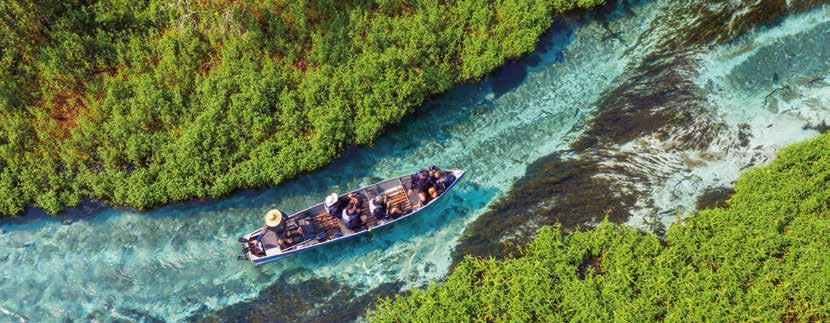
receives direct flights from Congonhas (CGH) and Viracopos (VCP) airports in São Paulo and Campinas, respectively. The overland access from Campo Grande, the state capital, is 245 km via fully paved highway.
Bonito/Serra da Bodoquena is world-renowned for its incredibly crystal-clear waters, mysterious grottoes, and countless waterfalls. Among its main attractions, in the municipality of Bonito, is the Anhumas Abyss, with an exciting rappel descent of over 70 meters in suspension up to a stunning lagoon at the bottom of the abyss where you can snorkel or admire rock formations from a boat, or even practice certified scuba diving or as a novice.
Visiting the Blue Lake Cave (Gruta do Lago Azul), whose name refers to the incredibly transparent and blue lake located at its bottom, is an unforgettable experience, as well as visiting other grottoes in the region, known for their curious rock formations (speleothems) meticulously sculpted by nature over hundreds of thousands of years.
In the region, you can also explore the Mysterious Lagoon (Lagoa Misteriosa) with astonishingly clear waters and unknown depth, with visibility exceeding 40 meters, offering snorkeling and diving tours in a submerged cave. This attraction is located in the municipality of Jardim, which also hosts other activities, including the Macaw’s Hole (Buraco das Araras), the largest doline in South America, visited by ecotourists and birdwatchers from around the world.
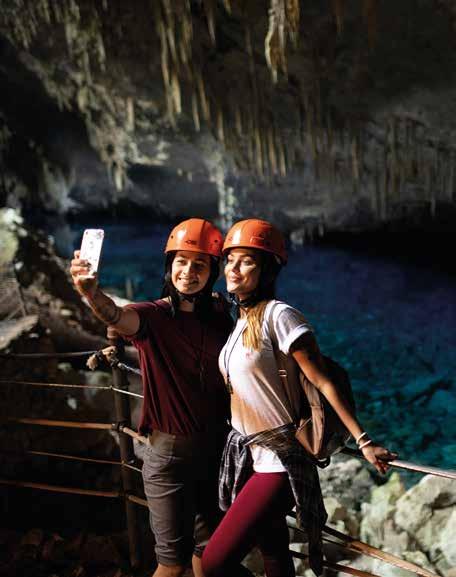
In the municipality of Bodoquena, which is also rich in attractions with crystal-clear waters, the main chal lenge is the Jaguar’s Mouth (Boca da Onça) Ecotour, with 90-meter rappelling descent in total suspension, overlooking the beautiful Salobra River Canyon below.
In the Bonito/Serra da Bodoquena region you can also enjoy the rivers Prata, Formoso, and Sucuri, with many waterfalls and some of the world’s clearest springs, as well as rapids ideal for activities such as kayaking and stand-up paddleboarding, tubing, ziplining, and hiking through riparian forests.
The region offers many hotels, inns, besides inter national-quality resorts, with diverse tourism support infrastructure regarding food, and adventure with se curity and guides specialized in natural attractions. Another highlight is the regional cuisine, featuring red meats, fish, and even caiman in delicious exclusive recipes. These mouth-watering options will certainly make your trip even more unforgettable.

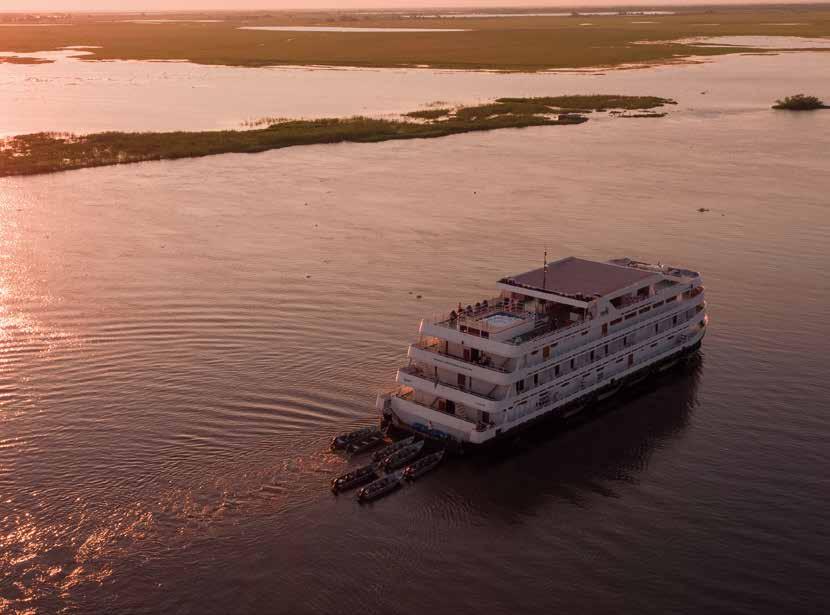
About 67% of the world’s largest floodplain is located in the state of Mato Grosso do Sul. The Pantanal is a paradise for ecotourism enthusiasts and a crucial area for environmental balance. The biome is home to over 260 fish species, 650 bird species, 50 mammal species, 40 amphibian species, and over 50 reptile species, which make the biome is one of the world’s largest wildlife sanctuaries. Large mammals like jaguars, tapirs, marsh deer, and howler monkeys, reptiles like the Pantanal caiman, and hundreds of bird species like storks, blue, red, and yellow macaws, and species exclusive to the region attract visitors from all over the world.
Due to its extensive territory and diverse geography, the Pantanal can be visited year-round. Each season offers distinct opportunities for unforgettable trips.
On land, the Pantanal can be experienced in farm hotels and rural inns, some of which are century old, mainly located in the municipalities of Corumbá, Miranda, and Aquidauana. These offer programs such as day and night wildlife safaris, river cruises, horseback riding, ecological trails, birdwatching, experiencing the culture of the Pantanal cattleman, and much more.
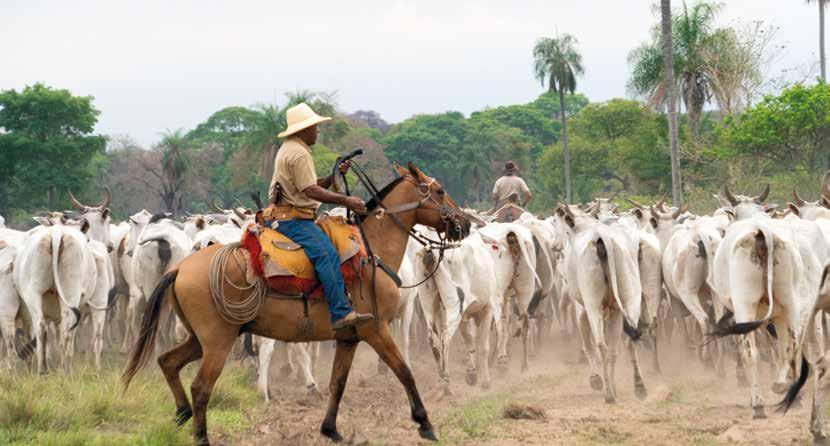

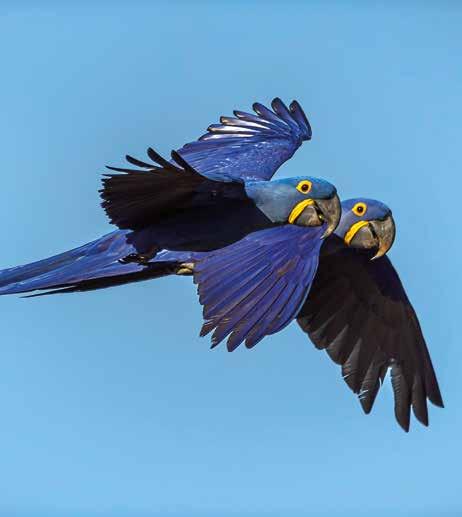
By water, ecological river cruises on the Paraguay River are unforgettable attractions for families seeking contemplative experiences and sport fishing enthusiasts (catch and release), with options for first-class hotel boats. For sport
fishing enthusiasts, both the Paraná River Basin and the Pantanal offer a great diversity of highly sporting fish, along with extensive infrastructure to welcome anglers and provide an incredible fishing experience.
Another must-visit region is the Pantanal Park Road (Estrada Parque Pantanal), which attracts tourists from around the world for wildlife observation, especially birdwatching, along its route by foot or in specially adapted vehicles. Along its route, there are several farm hotels specially designed to accommodate ecotourists and sport fishers, as well as horseback riding and
river cruises on the Miranda River.
The Pantanal is not only incredible for its lush nature but also for the opportunity to learn about and experience its traditions, culture, and especially its delicious cuisine through the Pantanalian Gastronomic Routes, with flavors that will remain in visitors’ memories forever.


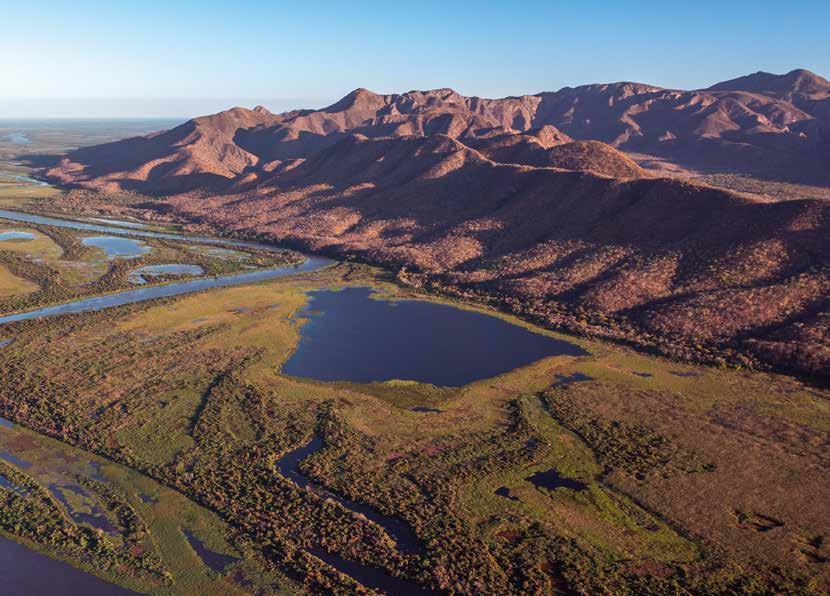
The capital of Mato Grosso do Sul, Campo Grande, is a modern city with much to offer, such as the Bioparque Pantanal (Biopark Pantanal), the world’s largest freshwater aquarium. A globally recognized attraction, it houses over 300 fish species from all continents in a gigantic structure that also includes a research and study center. The Bioparque is located in the Parque das Nações Indígenas (Indigenous Nations Park), one of Brazil’s largest urban parks, where the Helena Meirelles Acoustic Shell, the Museum of Contemporary Art (Marco), and the Museum of Cultures Dom Bosco
Other recommended tours in the capital include the Casa do Artesão (Craftsman House) and Mercadão Municipal (Traditional Municipal Market), where you can find an indigenous fair and regional products ranging from handicrafts to spices and the typical mate herb used to prepare the most typical cold drink of Mato Grosso do Sul: the tereré. For those who want to savor another local exclusivity, the famous caiman pastry is also a must-try. The Feira Central (Central Fair) is another place that is part of Campo Grande’s identity, resulting from the mix of people from all re -
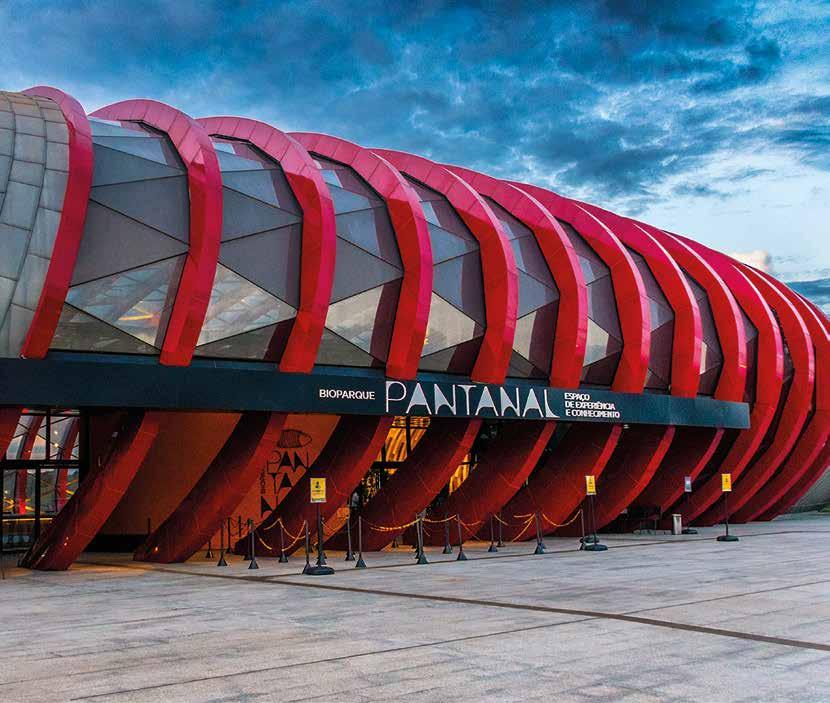
guayans, Bolivians, Lebanese, and Japanese, among others. The Feira Central is our oldest and most traditional gastronomic corridor, where you can taste a variety of flavors, such as the Sobá, a Japanese-origin dish declared Cultural and Immaterial Heritage of Campo Grande. The location also hosts culinary and cultural festivals throughout the year and more than
100 commercial establishments selling everything from regional items to electronic products.
The capital is not left out of adventure. The Campo Grande dos Ipês tourist region also offers trails, rappelling, canyoning, bike tourism, rural tourism, waterfall baths, and various nature activities.
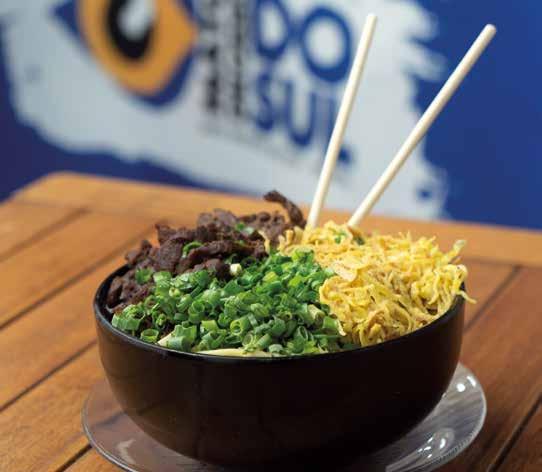

OFFICIAL NAME:
Federative Republic of Brazil
GOVERNMENT SYSTEM: Federative Presidential Republic
PRESIDENT: Luiz Inácio Lula da Silva
CAPITAL: Brasília
OFFICIAL LANGUAGE: Portuguese
LOCATION: South America
AREA: 8.516 million km²
POPULATION: 212.6 million
Brazil is attracting more and more foreign visitors. Between January and September 2024, the number of tourists from other countries increased by 12% compared to the same period last year. The country now has 4.897 million international travelers. This is the best result recorded in the historical series (1989-2024) for the month of September. In September alone, 445,389 foreign tourists landed in Brazil, an increase of 26.4% compared to September 2023. Throughout the year, September stands out as the fourth best month for receiving international visitors, behind only January, February and March, the high season period. Argentina remains the main source of tourists, with more than 1.4 million visitors since the start of 2024. In se-
cond place, the United States has sent more than 518,000 visitors, followed by Chile with 454,225. European countries such as France, Portugal, Germany, the United Kingdom, Italy and Spain together accounted for 741,614 tourists who crossed the Atlantic to visit Brazil.
The National Tourism Plan (PNT) 2024-2027, recently launched by the Ministry of Tourism, aims to position Brazil as the top tourist destination in South America. The plan targets attracting 8.1 million foreign tourists annually and generating US$ 8.1 billion in revenue from their spending. Given the current trends, there is an expectation to exceed 10 million international visitors during this period.
CITIES: 5.570
DIVISION: Brazil is divided into five regions with 26 states, plus the Federal District (DF).
OFFICIAL TIME ZONE IN BRAZIL: GMT - 3
INTERNATIONAL PHONE CODE: +55
OFFICIAL WEBSITES: www.brasil.gov.br e www.turismo.gov.br
MINISTER OF TOURISM: Celso Sabino
PRESIDENT OF EMBRATUR: Marcelo Freixo


BRAZIL IS ON THE RIGHT TRACK TO ATTRACT MORE INTERNATIONAL
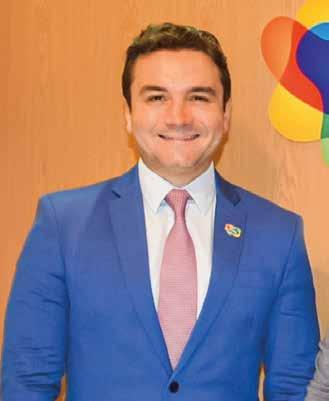
The year of 2024 continues on a path towards the consolidation of international tourism in Brazil.. The official forecast indicate that Brazil is on the right track to achieve better results in attracting international tourists. Between January and September 2024, the number of tourists from other countries increased by 12% compared to the same period of 2023. The country already has 4.897 million international travelers.
The Minister of Tourism, Celso Sabino, evaluates the positive scenario of tourist activity in the country. “Brazil has strengthened its brand on the international stage. We have worked to showcase our attractions and destinations, presenting all the cultural and gastronomic diversity and natural beauty that can only be found here. Our mission is to reach double digits in the number of foreign tourists by 2027,” he says. Check out the interview with him below.
Mercado & Eventos - Brazil has reached ever higher and better levels in tourism. To what do you attribute this success?
Celso Sabino - I believe that the good numbers are the result of consistent work and a set of actions that
have been implemented. The improvement of tourist infrastructure, with more than 500 projects financed, and the investment of R$ 380 million are essential. In addition, the international promotion of Brazil has been reinforced, showing the world that we are a safe destination, rich in natural beauty, culture and gastronomy.
M&E - What specific actions has the Ministry of Tourism taken to attract more international visitors?
Celso Sabino - We have focused on expanding the international air network and creating new flights. The International Tourism Acceleration Program (PATI), in partnership with Embratur and the Ministry of Ports and Airports, has already brought a significant increase in seats on foreign flights to Brazil. All this has contributed to more tourists discovering our country.
M&E - What is your assessment of Brazil’s promotion abroad?
Celso Sabino - Brazil has established itself as an attractive and competitive destination on the international stage. We are receiving visitors with an incredible diversity of tourist experiences, and this is a reflection of our work together with several organizations and our efforts to present the best of what we have to offer.
M&E - What about the growth in spending by international tourists?
Celso Sabino - The increase in spending is directly related to the strengthening of promotional activities and our commitment to making Brazil an increasingly accessible and desirable destination. We are breaking through the six million tourist barrier, which demonstrates the effectiveness of our initiatives.
M&E - What are the next steps for tourism in Brazil?
Celso Sabino - We will continue to invest in infrastructure, promote Brazil abroad and expand the air network. Our goal is not only to reach, but to surpass the 7 million figure for international tourists, consolidating Brazil as one of the world’s main tourist destinations.


MARCELO FREIXO, PRESIDENT OF THE AGENCY, HIGHLIGHTS THE IMPORTANCE OF THE UK MARKET
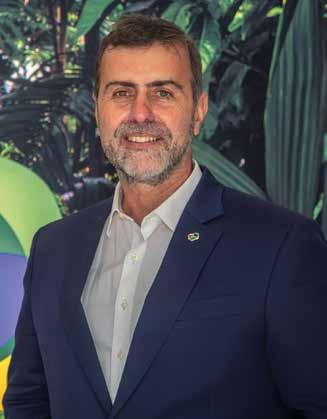
Record-breaking numbers and well-thought-out strategies define Marcelo Freixo’s vision for Embratur, which aims to promote Brazil as a sustainable and culturally rich destination. Freixo emphasizes the importance of collaboration between states, municipalities, and the private sector to maximize the impact of international marketing. In an interview with M&E, he discussed Brazil’s potential for growth in the British market and the significance of fairs like WTM London, which serve as essential platforms for strengthening partnerships and enhancing connectivity between Brazil and Europe.
Mercado & Eventos - This year has seen changes in the profile of international tourists. Will there be a focus on specific markets in the 2025 promotion?
Marcelo Freixo - We are observing an increase in segmentation as a trend. The number of tourists seeking diverse experiences has decreased, while those looking for specific experiences has risen. Consequently, we will increasingly focus on segmented promotions within our priority markets, carefully analyzing which
segments we are most competitive in under different scenarios. We will also invest in potential markets where we anticipate significant returns in the medium to long term, such as China. We’ve already begun to develop promotional strategies for the Chinese market, which will gain momentum in 2025.
M&E -Besides market segmentation, has Embratur been working on specific celebrative dates to promote Brazil abroad?
Marcelo Freixo - Since the beginning of our administration, we have adopted a strategy to promote popular festivals as expressions of our culture’s originality and richness. We’ve organized press trips and familiarization tours for events like Carnival, the Parintins Festival, and São João. Promoting these major events will continue to be a focus of Embratur’s planning. We are also working on promoting our sporting events calendar, as Brazil hosts competitions with significant international appeal. We’ve established partnerships to promote the Women’s Football World Cup, set to take place in Brazil in 2027.
M&E - How important is the UK market for Brazil?
Marcelo Freixo- The UK is the ninth-largest source of tourists to Brazil and the fourth in Europe. It’s crucial due to its high average spending. It ranks as the fourth largest source of tourists globally, and we see substantial potential for growth, with surveys indicating strong recognition and interest in visiting Brazil. Our strategy in this market focuses on expanding marketing efforts, particularly targeting operators who currently sell the most packages to our direct competitors, while working in partnership to enhance connectivity.
M&E- Why is participating in WTM London important?
Marcelo Freixo - It’s a vital opportunity to strengthen commercial relations within the European market. Our key message is to promote Brazil as a sustainable and diverse destination. We will focus on attracting new business and solidifying partnerships with major tour operators, OTAs, and airlines that connect Brazil with Europe.
MARKETING DIRECTOR OF BRAZIL’S TOURISM PROMOTION AGENCY SHARES NEWS AND EXPECTATIONS

As tourism recovers from the pandemic and global competitiveness increases, Brazil is poised to emerge as a standout destination. Embratur, the agency responsible for promoting Brazilian tourism abroad, is developing bold strategies to strengthen the country’s image in key markets. Next year, the agency will unveil a robust integrated marketing plan designed to transform the global perception of Brazil in the tourism sector. In an interview with M&E, Bruno Reis, Embratur’s Marketing Director, discusses the organization’s plans for participating in international fairs, the challenges of attracting tourists, and the significance of the new marketing strategy.
Mercado & Eventos - Which countries are experiencing organic growth, and which need more investment to capture markets?
Bruno Reis - We categorize Embratur’s activities into three levels: prospecting, consolidation, and opportunity markets. Generally, European markets are quite consolidated. For instance, Brazil holds the largest share of the British market compared to other South American countries, largely due to air connectivity. When a company like Air France increases
flights to Brazil, it signals organic growth.
In the European markets, aside from Spain, we have promising prospects for maintaining and even increasing our market share. The American market, however, is more competitive. We recently launched a campaign focused on the Amazon in New York, highlighting the need for greater investment in promotion and positioning within this market. Our goal for 2025 is to invigorate this segment through both product development and targeted marketing actions.
M&E - Could you provide an overview of tourism this year and your expectations for the end of the year?
Bruno Reis - We are seeing growth. Between January and August, Brazil welcomed nearly 4.4 million visitors. We anticipate reaching 6.4 to 6.6 million by December, which would set a new record. For 2025, we expect significant advancements in our positioning with the launch of the new international marketing plan, which will better define our strategies and target market segments. Brazil needs this plan, and we are committed to outlining actionable steps. With this initiative, not only Embratur but all states will develop operational plans that will streamline the execution of their activities. We are optimistic about the lasting impact this will have on Embratur’s management and our short-, medium-, and long-term objectives.
M&E - Can you share some details about this marketing plan? Will there be a different strategy?
Bruno Reis - We are currently in the development phase, with plans to launch it in May 2025 during the Visit Brazil Summit in Rio de Janeiro. This event will bring together stakeholders to discuss the international promotion of Brazil and the future of tourism, focusing on sustainability, diversity, and innovation. The plan is collaborative; we are actively engaging with various tourism partners to ensure everyone can contribute. We also aim to involve new stakeholders, such as privatized airports and brands that promote ‘Brazilianness’ abroad, like Farm, Osklen, and Havaianas. These brands can help us leverage Brazil’s soft power in the international market. Our goal is to create actions that resonate more with the end consumer, as our relationships with industry partners have been well established for a long time. The challenge lies in effectively communicating with the public across different markets, which will be one of the key innovations of our marketing plan.
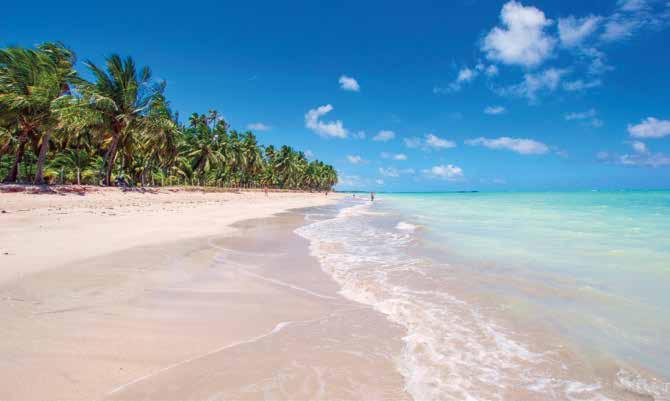
Maragogi is considered the Brazilian Caribbean
With an emerald sea, Alagoas has 235 kilometers of coastline full of white sand beaches and crystalline waters. The North Coast is also known as the Coral Coast, as it has the second largest barrier reef in the world, with 130 kilometers highlighted by the green of the coconut trees and the turquoise blue of the sea.
Despite being the third smallest Brazilian state and having only 3.5 million inhabitants, Serra da Barriga alone, where the Quilombo dos Palmares Memorial Park is located, has been visited by almost 7,500 people from 16 countries since it received the title of Cultural Heritage of Mercosul.
Among the tourist attractions, Maceió, the capital, Maragogi, Japaratinga, Barra de São Miguel, as well as Piaçabuçu, Marechal Deodoro and Piranhas stand out. Alagoas cuisine is a show apart, with many dishes based on fresh seafood.
Maceió, the capital of Alagoas, has the Zumbi dos Palmares International Airport as its gateway, which refers to the Quilombo dos Palmares Memorial Park, a place that reconstitutes the scenario of the largest, most enduring and most organized refuge for enslaved blacks in the Americas, where
Zumbi dos Palmares, the leader of the resistance, lived in the 17th century. The attraction is located about 88 kilometers from the city center, or approximately two hours by car.
Despite the historical and cultural wealth, it is the sun and the sea that catches the eyes of the tourists. Due to its geographical position, the sun rises shortly after 5 am and sets around 6 pm, so the tip is to wake up very early and dive into the green waters of the sea, as in Ipioca Beach, which is 20 kilometers away from the city center. The beach has an extensive strip of reddish sand, with strong waves and sandbanks. There is also an on-site beach club and a viewpoint, in addition to the home of Marechal Floriano Peixoto, the second president of Brazil and an important figure in the country’s history.
Another famous beach is Ponta Verde, considered the most beautiful in the city. Cruz das Almas, located 6 kilometers from the center of Maceió, is the stage of local, regional and national surf competitions. Jatiúca Beach can’t be left out of your itinerary either. Considered one of the most popular in the entire state, Pajuçara beach also has a good structure of hotels, inns and restaurants and is a great option for families. In addition to the nautical activities, one of the most attractions is its nightlife, with clubs, bars and restaurants.

CAPITAL: MACEIÓ OFFICIAL WEBSITE: WWW.SETUR.AL.GOV.BR


The sunset at Maceió’s beaches is one of the favorite activities of travelers
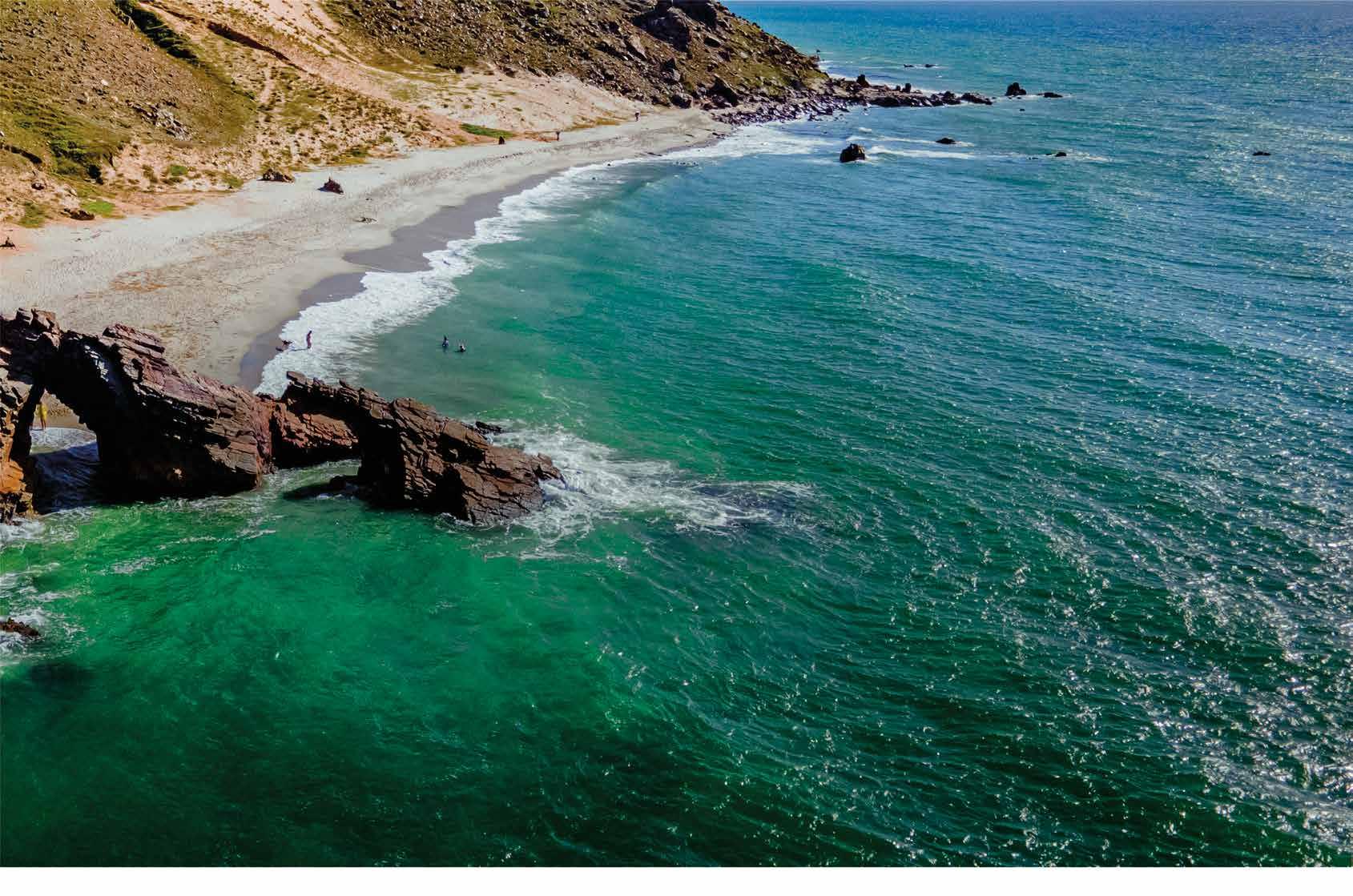

To go on an adventure or to contemplate nature, enjoy the experiences that only a continental country can offer. Colours, flavours, and experiences that you can’t find in any other place. Brazil is a unique destination, with numerous indescribable trips.
Visit our booth at WTM S5-200.
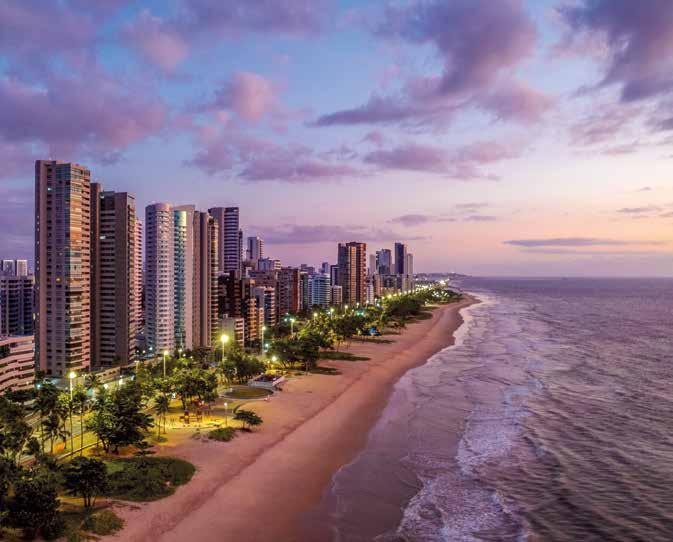
Rich cultural identity. Natural Beauties. Exquisite cuisine. More than 185 kilometers of beaches. A hospitable people. This is Pernambuco, which invites all European and foreign tourists to truly “Pernambucar” and discover everything the state has to offer. Pernambuco is a place of beach, sun, heat, coconut trees, high quality gastronomy, culture and a lot of history in a single place. The flagship there are the beaches, but the truth is that from the coast to the Sertão, the state offers its admirers an attractive combination of culture and modernity.
Pernambuco breathes, lives and always reinforces its traditions and customs. Whether it’s Carnival, June festivals or even in low season, no matter what time you decide to visit the state, you’ll certainly be enchanted by the rhythm of Frevo, Maracatu and the taste of the
delicious roll cake. From the capital to the interior, the destinations offer natural beauties, gastronomic and artistic riches characteristic of all the people of Pernambuco, starting, of course, with the capital Recife.
“I came back, Recife. It was nostalgia that took me by the arm.” One of the great Brazilian singers and songwriters, Alceu Valença, immortalized the capital of Pernambuco in his music. In the song, Alceu tells a little about Recife’s culture, such as the Frevo power, and highlights precisely the nostalgia he has for Recife. So this is the first tip: if you are going to visit Recife, get ready, because the longing to come back is very strong. It really is a captivating city. There, the sun rises very early, an invitation to enjoy beaches, rivers, green areas and historic buildings. The beaches most sought after by tourists in the region are
Boa Viagem and Pina, which have shores with many coconut trees, in addition to a sea of warm, greenish waters. From Boa Viagem to Recife Antigo, which has Rua do Bom Jesus as a reference, Recife has a lot to surprise. There are churches, colonial houses and museums that keep the rich history of the state. The metropolis also has an infinity of restaurants specializing in seafood and a lively nightlife, rocked by the rhythms of Pernambuco. Gastronomy is a separate chapter, with typical elements, including seafood, beef jerky, green beans, the aforementioned roll cake, coalho cheese, among others.
We have one last tip. To the sound of frevo, maracatu, afoxé, samba, pop and so many other rhythms that characterize the unique diversity of Brazilian culture, plan to discover the Carnival of Recife. For more than a month, the city celebrates the Carnival Cycle, honoring its cultural traditions. There are more than two thousand presentations distributed in more than 60 carnival centers. The highlight of Carnival, of course, could not be different: the gigantic block of Galo da Madrugada, which literally drags millions of Pernambuco and tourists through the streets of downtown Recife as soon as the sun rises. It is normal to wake up very early to enjoy the most famous block in the city. In addition to it, parties spread throughout the city, such as Pátio de São Pedro, Marco Zero, Praça do Arsenal da Marinha and Avenida Guararapes. Considered the biggest block in the world, Galo da Madrugada always parades on Carnival Saturdays.
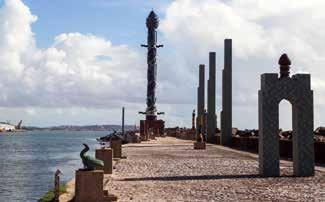
CAPITAL: RECIFE
OFFICIAL WEBSITES: WWW.SETUR.PE.GOV.BR/ WWW.EMPETUR.PE.GOV.BR
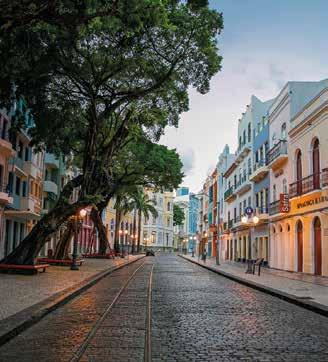

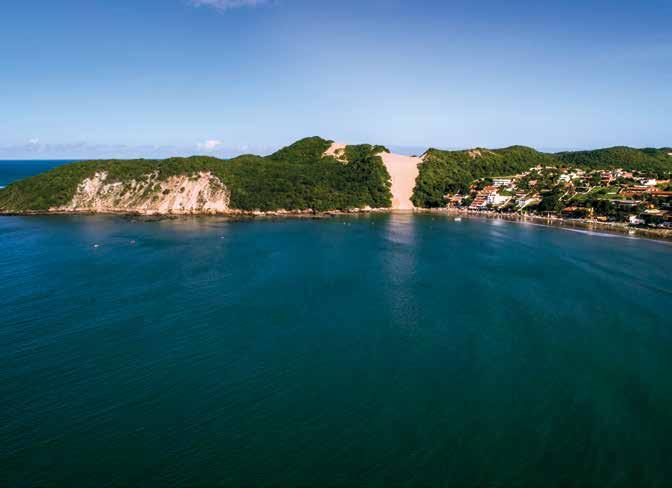
Located in the Brazilian Northeast, Rio Grande do Norte is a state with about 3.5 million inhabitants distributed in 167 municipalities, many of which stand out for tourism. With an area of 52,809 square kilometers, the state borders Paraíba and Ceará.
With a tropical climate, Rio Grande do Norte has vegetation predominantly belonging to the Caatinga, in addition to formations of Mangrove, Restinga and Atlantic Forest. During its colonization passed some European immigrants, especially Portuguese, French and Dutch, as well as indigenous natives and African populations, influencing the local culture.
The city of Natal, capital of Rio Grande do Norte, is the birthplace of postcards such as Morro do Careca, located on Ponta Negra Beach, Barreira do Inferno and Forte dos Reis Magos. The city is also home to Parque das Dunas, the second largest urban park in the country. The attraction is also recognized by Unesco as an integral part of the
Brazilian Atlantic Forest Biosphere Reserve.
As we mentioned above, there is no shortage of attractions in the state capital. Forte dos Reis Magos is a military building built in 1949 to protect the Portuguese who were in conflict with the French and the Indians. At the site, which is on the banks of the Potengi River and is also the city’s first construction, it is possible to find artifacts from the time when it was active.
You cannot miss the Mercado da Redinha, which is located on Praia da Redinha, at the mouth of the Potengi River, and which is considered an intangible heritage of Natal or even the contemplation of the sunset during the catamaran ride on the same river. On Pirangi beach is also the largest cashew tree in the world. It has an area of approximately 8,500 square meters of canopy and produces about 2 and
a half tons of fruit per harvest.
In the West Zone, there is the Costa Branca, a region that is home to virgin beaches, where the vegetation of the hinterland meets the sea, colored by the dunes and cliffs. Among the highlights are Soledade beach, in the oil prospecting area. It has a different look, a result of the constant burning of gases from oil exploration. At night, the fire torches become a tourist attraction.
Close to Ponta Negra, Barreira do Inferno, the Brazilian Air Force Base, is the first in South America for rocket launches and draws attention for its vibrant red tone at dawn, which reflects the sun’s rays into the sea. The name was given to the cliffs by local fishermen. The attraction is on Rodovia RN 063 Km 11, in the city of Parnamirim, in the Metropolitan Region of Natal.
CAPITAL: NATAL OFFICIAL WEBSITES: WWW.EMPROTUR.SETUR.RN.GOV.BR/ WWW.SETUR.RN.GOV.BR
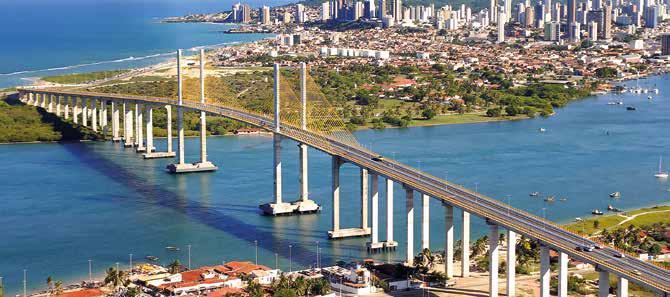
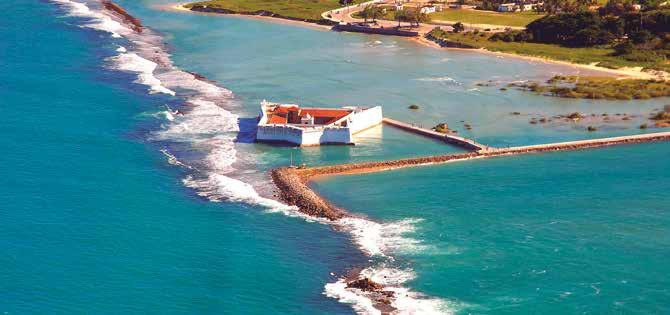

Maranhão, one of Brazil’s most captivating states, has established itself as a must-visit tourist destination, celebrated for its natural and cultural wonders. Among its most famous attractions are the Lençóis Maranhenses, a national park renowned for its stunning white dunes and crystal-clear lagoons. This extraordinary landscape enchants visitors from around the globe, offering activities like hiking, 4x4 tours, and refreshing swims.
The state also boasts an abundance of ecotourism opportunities, with highlights including Chapada das Mesas National Park and the Parnaíba Delta, where visitors can discover impressive biodiversity. With a growing infrastructure and warm hospitality, Maranhão is ready to welcome travelers seeking authentic and unforgettable experiences. If you’re planning your next adventure, Maranhão promises surprises and enchantment at every turn.
HISTORIC
São Luís is an enchanting city where each building in the
Historic Center invites you on a journey through time, filled with stories that contribute to its unique charm. Designated a Unesco World Heritage Site since 1997, São Luís features a well-preserved layout dating back to the 17th century. Its streets showcase an architectural ensemble of Portuguese origin, representing the largest urban agglomeration of tiles in Latin America, with over 4,000 listed buildings nestled throughout its streets, alleys, and staircases.
The Historic Center of São Luís is a vibrant hub for the arts, literature, and cinema. Many historic buildings have been transformed into museums, theaters, craft stores, inns, bars, and restaurants, offering a unique blend of opulence and cultural richness.
The combination of art, history, and culture, along with the city’s beautiful coastline, makes São Luís the perfect gateway to explore Maranhão. With 37 km of urban and semi-deserted beaches ideal for surfing and kitesurfing, the urban area also offers excellent infrastructure for walking and cycling, complete with bike paths, bars, restaurants, hotels, inns, and various services.

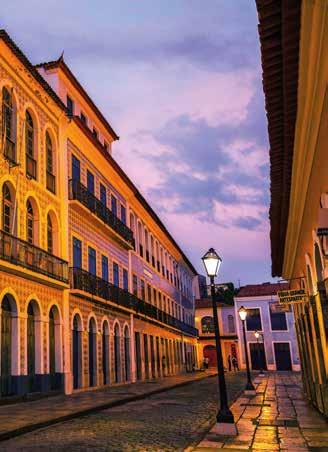
Maranhão is also a must for ecotourism lovers, with destinations such as Chapada das Mesas
CAPITAL: SÃO LUÍS
OFFICIAL WEBSITE: WWW.TURISMO.MA.GOV.BR

The Palácio dos Leões, an iconic building in the historic center of São Luis
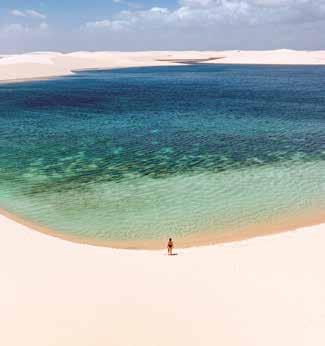
The paradisiacal and cinematographic Lençóis Maranhenses
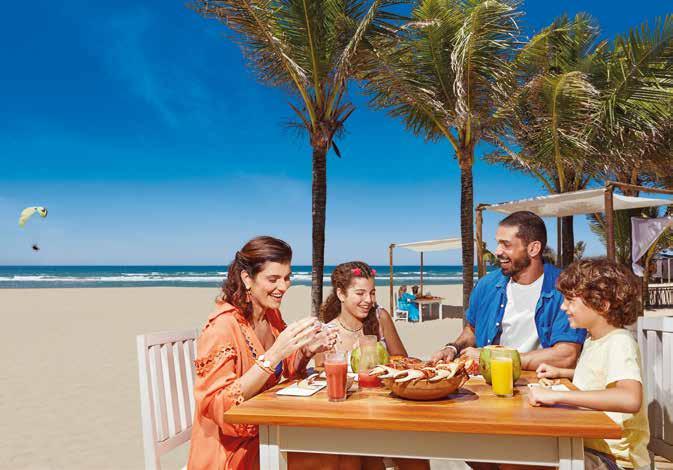
Ceará, a state of the Northeast region, is known for its beautiful beaches, which attract the interest of tourists from all over the world. The local culture is the result of the influence of indigenous and Africans, as well as Europeans. Handicrafts are one of the main cultural expressions in the state and are commonly made with leather, straw, clay, wood or sand.
There is also cordel literature and woodcuts, which tell stories in the form of verses. The cordel was even recognized as a Brazilian Intangible Cultural Heritage. In terms of parties and nightlife, the Reisado, the Caninha Verde Festival, the Festas Juninas and the Festa da Banda Cabaçal are very popular in Ceará.
The gastronomy is rich and makes massive use of fish, all kinds of seafood, dried meat, cheese, cassava manioc and lots of seasoning.
Fortaleza has a plurality of tourist options, whe -
ther in contact with nature or cultural, there are many attractions. Among the most famous places are Praia de Iracema, Praia do Meireles, Praia do Futuro and the Historic Center.
Theatro José de Alencar is one of the main tourist attractions in Fortaleza and a symbol of Ceará art. It is possible to take a free guided tour for about an hour. It is also worth including in the itinerary the Dragão do Mar Center of Art and Culture, a space that houses the Ceará Culture Museum; Ceará Contemporary Art Museum; a cinema; the Rubens de Azevedo Planetarium and an Amphitheater, where several free performances of the most diverse artistic genres are held.
Praia do Futuro, with its bathing facilities and innumerous tents, has established itself as a mandatory stop for anyone visiting Fortaleza. There is also Praia de Iracema, which is one of the most popular places in the capital. The place has a pier popularly known as Espigão da Praia, where you can watch the sunset.
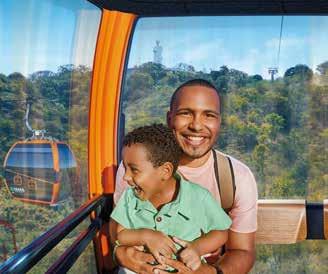
CAPITAL: FORTALEZA
OFFICIAL WEBSITE: WWW.SETUR.CE.GOV.BR
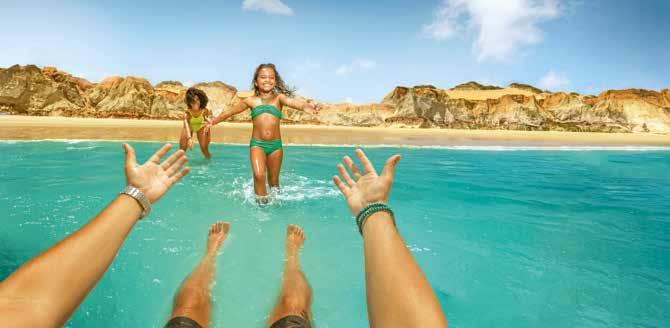
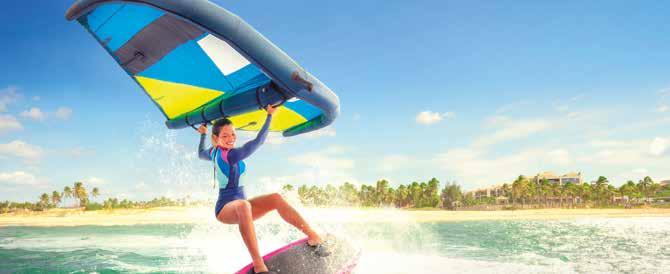
It is possible to practice water sports, such as

In addition to rivers, forests and exotic animals, the Amazon is formed by a set of ecosystems that involves the entire hydrographic basin of the Amazon River, considered the region with the greatest biodiversity on the planet and the largest biome in Brazil.
The local culture has indigenous influences from the native people, as well as European and African influences, which is also reflected in the Amazonian folklore and its traditions, in addition to composing and demonstrating the characteristics of the region as elements of the formation of the Amazonian identity.
When it comes to nature, the “Meeting of the Waters (pt: Encontro das Águas)” of the Negro and Solimões rivers, intangible heritage of Manaus, is one of the most popular tours by tourists and visitors.
Manaus is also home to the Teatro Amazonas, one of the most important theaters in Brazil and the city’s main postcard. The monument has an “art nouveau” style architecture and harmonizes with other nearby buildings, all built during the Rubber Cycle, when the Amazonian capital was the economic center of the country.
Other attractions of the capital that cannot be overlooked are the Adolpho Lisboa Municipal Market, the Amazon Museum (MUSA) and the Seringal Museum, as well as The Metropolitan Cathedral of Nossa Senhora da Conceição, the Palácio Rio Negro Cultural Center and the Municipal Clock (recently restored), all in the Historic Center of Manaus.
Also noteworthy is the Janauari Reserve, home to the main species of Amazonian flora, such as the water lily and the samaumeira, a leafy tree typical of the Amazon floodplain that serves as a shelter for the inhabitants of the forest.
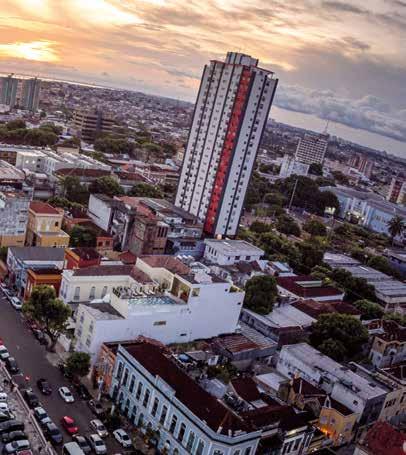
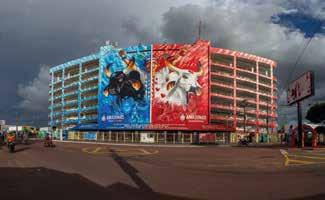
CAPITAL: MANAUS
OFFICIAL WEBSITE: WWW.AMAZONASTUR.AM.GOV.BR
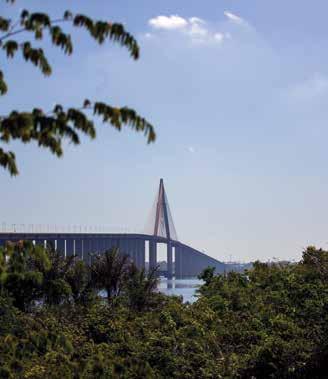

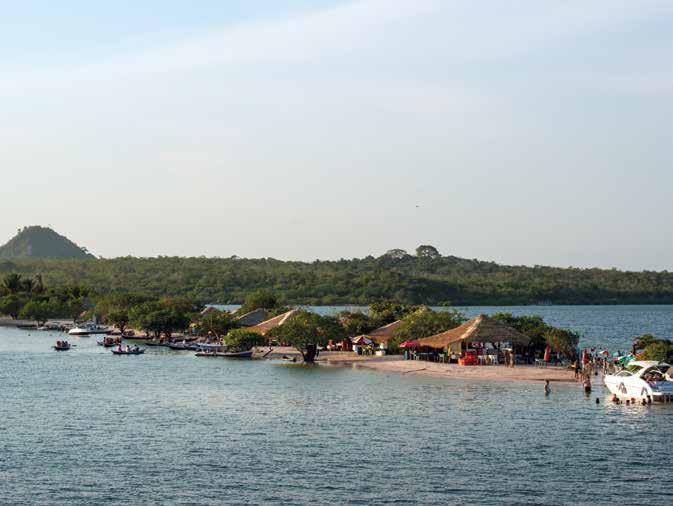
Pará stands out for its vocation for Ecotourism, as it covers part of the Amazon Forest. Its territory is marked by regions of Mangrove and Cerrado, in addition to having the coast bathed by the Atlantic Ocean. Its formation has a strong contribution from Portuguese, French and Japanese influences.
In addition, Pará is home to approximately 31 indigenous ethnicities, which, in part, are responsible for the strong influence on Pará cuisine, which is characterized by the use of fish and leaves (chicory, coriander, in addition to maniva – ground manioc leaves), hot peppers, local herbs and fruits.
The capital Belém is a city located in the bay of Guajará. Among its tourist attractions, the Estação das Docas
is one of the most popular, a place that houses a gastronomic complex that has also become a meeting point and sunset observation point.
However, the Ver-o-Peso Market, considered one of the oldest public markets in the country, elected one of the 7 Wonders of Brazil, is the biggest postcard of Belém. It brings together the Iron Market, the Fisherman’s Square, the boat dock and the largest open-air market in Latin America, which offers regional and exclusive spices, food, herbs and medicinal products.
Your itinerary through the capital should also include the Museu do Forte do Presepio, the Mangal das Garças and the Theatro da Paz, a neoclassical building inspired by the Scalla in Milan.
The city is also known for its vocation for religious Tourism, especially with the Círio de Nazaré, an event that takes place for 15 days in October, when the pilgrimage held on the second Sunday of the month happens.
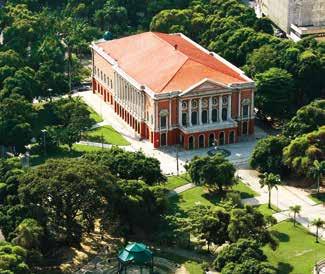
CAPITAL: BELÉM
OFFICIAL WEBSITE: WWW.SETUR.PA.GOV.BR
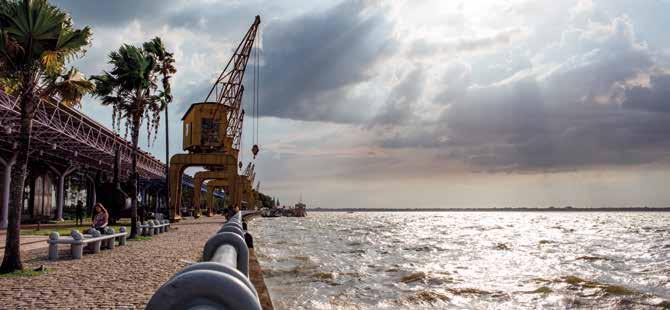
Estação das Doca The Estação das Docas is one of the destination’s tourist attractions as
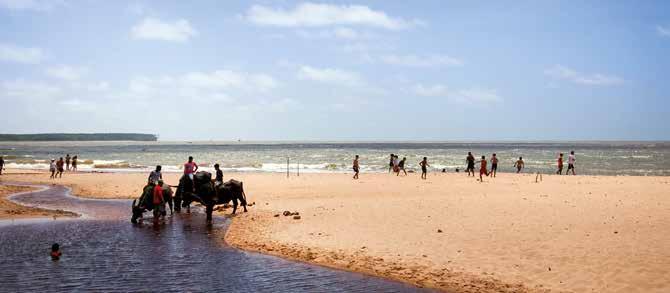
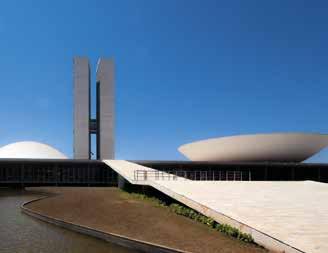
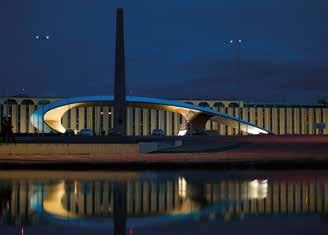
Stage of remarkable moments in the history of Brazil, the Federal District carries the title of Brazilian federal capital and has Civic Tourism as its strength, mainly because it houses buildings and monuments related to the national political scenario.
With about three million inhabitants, the Federal District is divided into 30 administrative regions, called satellite cities, including Brasília. Its construction culminated in the miscege-
nation of cultures from all over Brazil, which directly impacted local cuisine, culture and customs.
One of the DF’s vocations is the creative economy, which encompasses music, theater, dance, fashion and of course, tourism. The economic activity is primarily linked to the service sector, which corresponds to 71% of the workforce. However, tourism continues to advance and stands out more and more in generating employment and income since the 80s, according to data from the Federal Government.
Considered a World Heritage Site by Unesco, Brasília is a city of unique architecture and format, planned and built from scratch, in the shape of an airplane. Some of the main buildings related to the political scenario like Palácio da Alvorada, the Itamaraty Palace, the National Congress and the Planalto Palace, seat of the Presidency of the Republic were designed and developed by the renowned architect Oscar Niemeyer. The buildings can be visited on specific days and times.
Oscar Niemeyer’s works provide visitors with an open-air museum. This is a case of the Metropolitan Cathedral of Brasília, which, in addition to being one of the best known churches in Brazil, was also the first monument built in the city. Brasília also offers activities related to nature and extreme sports.
Parque da Cidade is one of the largest parks in Latin America and covers 40 hectares. For those who prefer water sports, Lake Paranoá is practically a freshwater beach and allows visitors to practice sports such as surfing, stand up paddle, canoeing, among others.
Another highlight of the city is the Brasília Capital do Rock Route, which pays homage important figures in the music scene in the 80. The route has 37 visiting spots that are part of the history of the city and the country and praise artists and bands such as Legião Urbana, Capital Inicial, Raimundos, Cássia Eller, among others.
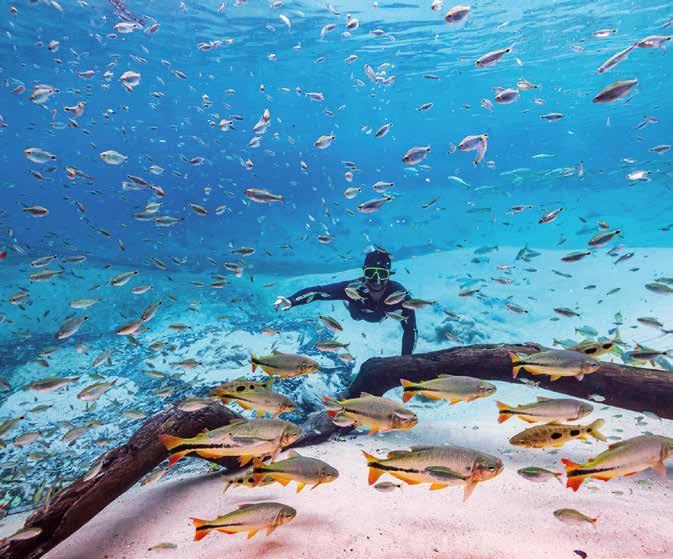
Untouched and exuberant nature, ecotourism, adventure tourism, rural tourism, fishing tourism and much more. The state of Mato Grosso do Sul, located in the Midwest region of the country, is made up of Serras, Cerrado, the largest floodplain on the planet and incredible scenery that make the destination unique.
The destination is full of natural attractions, such as waterfalls, caves, lagoons with crystal clear waters, state parks, caves, sightings of wild animals, among many other must-see sights that make Mato Grosso do Sul a true paradise of nature.
The state also won the title of one of the ten best destinations in the world for sustainable tourism. Rich in culture and history, the destination offers the chance to discover more about the development of the region since the arrival of the first settlers.
The capital and most populous municipality of Mato Grosso do Sul is Campo Grande. Located in a region of plateaus, the city has a breathtaking view and, due to the reddish color of its lands, it received the nickname of Cidade Morena. Among the attractions, the largest freshwater aquarium in the world, the Pantanal Bioparque, stands out. The attraction contains more than 7 thousand animals of 263 species, including fish, alligators and snakes in its 19 thousand square meters and 32 tanks. The focus of the tourist apparatus is to promote research projects and species conservation while entertaining and educating visitors.
With lively nightlife in contrast to the countryside feeling, the capital has numerous bars, restaurants, parties, mu-
seums, parks and monuments, such as the Memorial of Indigenous Culture, a cultural center located within the Marçal de Souza Urban Indigenous Village. Campo Grande is also home to the Parque dos Poderes, where you can find, during a walk, different species of animals such as anteaters, birds and marmosets.
An unmissable point in the city is the Morada dos Baís, which was listed by the Municipality of Campo Grande-MS for its cultural importance for the capital. The cultural center is formed by a historic building that completed 100 years in 2018 and is recognized as the first masonry townhouse in the city. Morada dos Baís houses the interesting museum Lídia Baís, which brings together personal objects from the family and works by the artist, as well as temporary exhibitions and also has three rooms reserved for exhibitions, a space for musical performances and a restaurant.
CAPITAL: CAMPO GRANDE
OFFICIAL WEBSITE: WWW.TURISMO.MS.GOV.BR
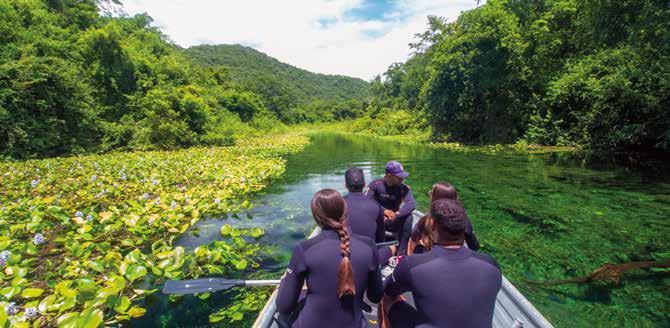
in Bodoquena,
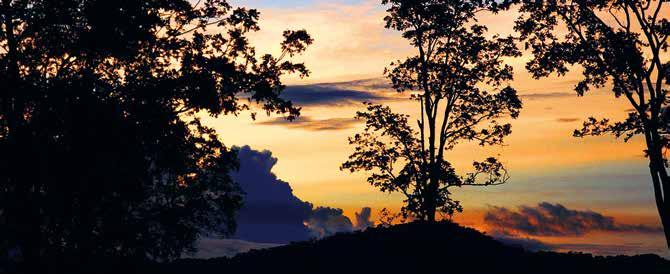
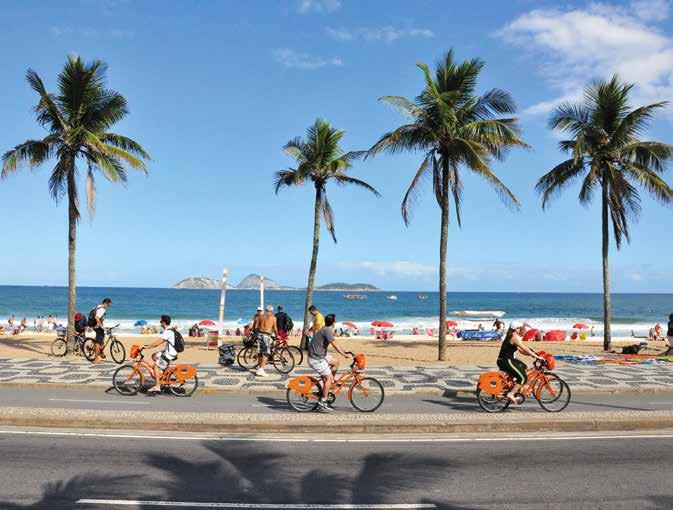
A 630 km coastline of incomparable beauty with several seaside sports options, the State of Rio has always been the gateway to tourists looking for more leisure and fun in Brazil.
The Mountain Region has its own culture, lower temperatures, waterfalls and natural beauties. Costa do Sol stands out with its popular beaches and cities well-known by tourists, such as Búzios and Arraial do Cabo. Costa Verde enchants for its ability to unite crystalline waters with large mountains of the Atlantic forest in several cities, such as Angra dos Reis and Paraty. Vale do Café impresses with all its history and culture from the rich coffee production on its historic farms.
Rio de Janeiro is a large Brazilian seaside city, famous for the beaches of Copacabana and Ipanema, the statue
of Christ the Redeemer at the top of Corcovado, and the Sugar Loaf Mountain, a granite peak that you can climb with cable cars. People who visit the destination can party in the neighborhood of Lapa and still take beautiful photos in the neighborhood of Santa Teresa.
In addition to the most famous beaches, you should also visit Prainha and Macumba beach. For surfers, the tip - with no margin for error - is Arpoador beach, which has a large rock from where you can see the sun setting between the amazing Morro Dois Irmãos.
For those who like sports, visiting Maracanã, one of the best-known football stadiums in the world, and Porto Maravilha, are mandatory tours. Porto Maravilha, by the way, now houses the new cultural and entertainment attractions for cariocas and tourists, such as the Museum of Tomorrow, AquaRio and Yup Star, the largest Ferris wheel in Latin America.
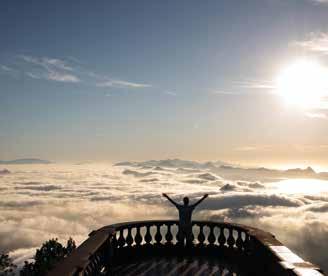
CAPITAL: RIO DE JANEIRO
OFFICIAL WEBSITE: WWW.SECTURISMO.RJ.GOV.BR
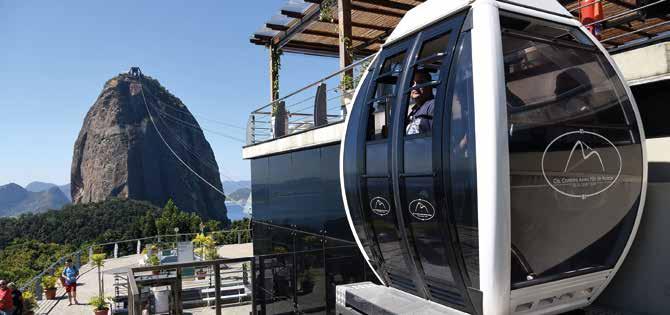

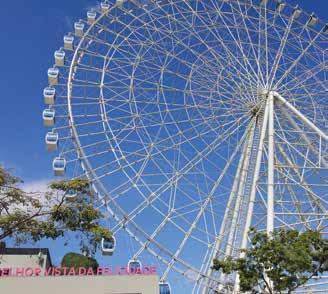
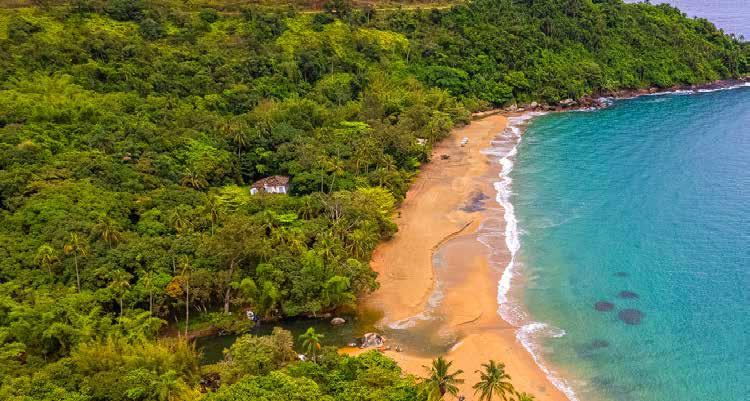
Located in the Southeast Region of Brazil, the State of São Paulo borders with Rio de Janeiro, Minas Gerais, Mato Grosso do Sul and Paraná. The capital is the city of São Paulo, the largest urban center in terms of population in Brazil. São Paulo has a diversity of landscapes, services and tours. The possibilities range from countryside landscapes, waterparks and thematic/amusement parks, beaches, waterfalls, main cities, museums, events and lots of business, which makes the state the most abundant destination in Brazil.
São Paulo is for everyone and anyone! It is the perfect place for those who love nature, as well as those who love gastronomy and culture. Known as the financial center of Brazil, the capital is a major entertainment center, and also the richest city in South America.
There are many options for dining and nightlife spots. Avenida Paulista, for example, is one of the postcards of the capital and reunites several activities options, such as visiting the MASP (The São Paulo Museum of Art) and the viewpoint in Sesc Paulista. On Sundays the avenue is
closed to cars and people can walk around and enjoy it as well as practicing sports such as cycling. Paulista Avenue is the stage for cultural agitators, artists and sellers of all sorts of products, objects and services.
The destination is also home to a rich architecture, with emphasis on the Martinelli and Copan buildings, the colonial-style church known as Pátio do Colégio, The New Museum of the Portuguese Language, MASP and Paulista Avenue itself.
Among the tourist activities, the most common in “Sampa” - affectionate nickname of the city, is to enjoy the restaurants, discover the cultural diversity that can be found in every neighborhoods, such as Liberdade, Moema, Vila Mariana, Vila Madalena, Itaim Bibi, Pompeia and Pinheiros, and enjoy the nightlife, which also extends to the ABC Region.
Currently, a MUST GO place, among so many other cultural and tourist attractions that the city of São Paulo offers, is the recently reopened Ipiranga Museum. After nine years closed for restoration, recovery of part of the collection and expansion, the Museum reopened its doors to the public in September 2022, with an exhibition area three times larger than when it closed, back in 2013.

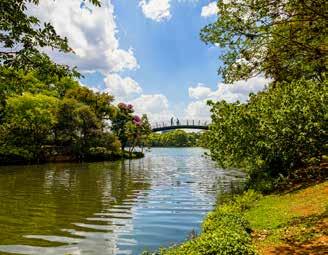
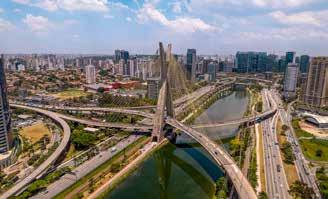
CAPITAL: SÃO PAULO
OFFICIAL WEBSITE: WWW.TURISMO.SP.GOV.BR



The State of Minas Gerais draws attention for the beauty of its parks, squares and ecological refuges.
Minas Gerais has always been a key part of Brazil’s economic development, both during the Gold Rush and afterwards, in the immense and well-known coffee plantations. Today, it is the main piece for those who seek culture, history and good gastronomy.
In addition to fitting into several national and worldwide tourism trends, Minas Gerais creates its own trends. Through the year of mining, the intrinsic attri -
butes of what it means to be a miner are valued and presented to tourists, enriching their roots and preserving knowledge and skills.
In Belo Horizonte, the options for those who enjoy nature, cultural and historical heritage are endless. There are museums, cinemas, parks, theater, mountains and observatories to be explored during the day.
At night, world capital of bar is always full of beautiful and cheerful people.
‘Beagá’, as it is usually called, has several attractions in its urban landscape, especially the Architectural Complex of Pampulha and Praça da Liberdade. In Pampulha, one of the main attractions is the Church of São Francisco de Assis, a postcard of the city and one of the nicest piece of work of the famous architect Oscar Niemeyer. The circuit is so beautiful and special that Unesco recognized it as a World Heritage Site.
Another outdoor tour tip is the Pampulha Ecological Park. The Liberdade Circuit, created in 2010, is also another important tourist attraction in the capital. You should also visit the Palácio da Liberdade, the House of Cultural Heritage of Minas Gerais and the Academia Mineira de Letras.
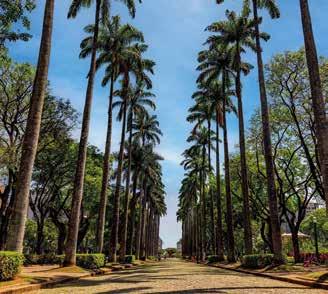
CAPITAL: BELO HORIZONTE
OFFICIAL WEBSITE: WWW.SECULT.MG.GOV.BR

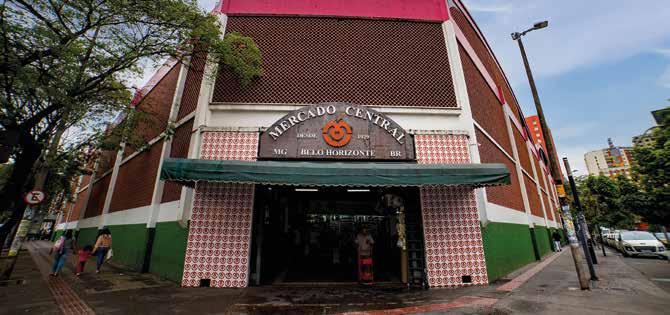

The State of Paraná, located in the south region of Brazil, is home to one of the seven wonders of nature, the Iguaçu Falls and the most ecological capital of Brazil, the city of Curitiba. Paraná is a complete destination, with attractions ranging from beaches to large cosmopolitan urban centers, beautiful mountains to imposing waterfalls. The destination has a rich biodiversity and tourist attractions divided into 14 regions.
The local gastronomy also deserves attention. It is possible to delight yourself with the famous “Barreado”, a typical dish of the coast of Paraná, which is composed of a beef stew cooked in a clay pot, served with manioc flour, banana and rice. Another dish worth mentioning is the ground rib, in addition to several recipes made with Pinhão, a seed typical of the region.
The capital Curitiba does not disappoint when it comes to tourism attractions. Cosmopolitan, technological and extremely sustainable, the destination is a true mecca of culture, history, architecture with lots of indoor and outdoor leisure options. Among the main tourist attractions in the city are the Panoramic Tower, which has an observatory at the top; the Ópera de Arame, a tubular steel structure with a transparent roof; the Oscar Niemeyer Museum, the
Holocaust Museum, the Egyptian and Rosacruz Museum.
The great postcard of the destination, however, is the Jardim Botânico de Curitiba, one of the most visited tourist spots in the city, opened in 1991. The Botanical Garden is made up of an iron construction with 3,800 pieces of glass, which works as a greenhouse for countless plant specimens from Brazil and other countries. In the outdoor area, the landscape is complemented by the charming, well-kept geometric gardens, as well as fountains spread throughout the 245,000 m² park. It is the ideal place to have an outdoor picnic and recharge your batteries in the middle of the urban center.
In fact, there is no shortage of parks and open and green areas in the city. In Barigui Park, one of the main ones in the capital, it is possible to find capybaras living by the lake. Tanguá Park is the best place to watch a beautiful sunset. Bosque Alemão also has its own charm, ideal for hiking and relaxing with a nice breeze.
In the architecture and in the local cuisine, it is possible to perceive a strong European influence, which is also reflected in the city’s open fairs, such as the Feira do Largo da Ordem, located in the historic center of the city, which also has numerous options of things to do. Finally, the Batel neighborhood is the perfect place to enjoy the nightlife and have a good beer or a nice cocktail in the bars.
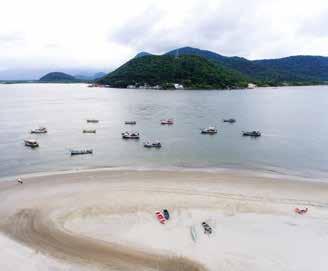
The charming and bucolic Caieiras Beach in Guaratuba, Paraná
CAPITAL: CURITIBA
OFFICIAL WEBSITE: WWW.TURISMO.PR.GOV.BR

Kattamaram tours are an excellent way to explore Foz do Iguaçu

The wonderful Iguaçu Falls in Paraná
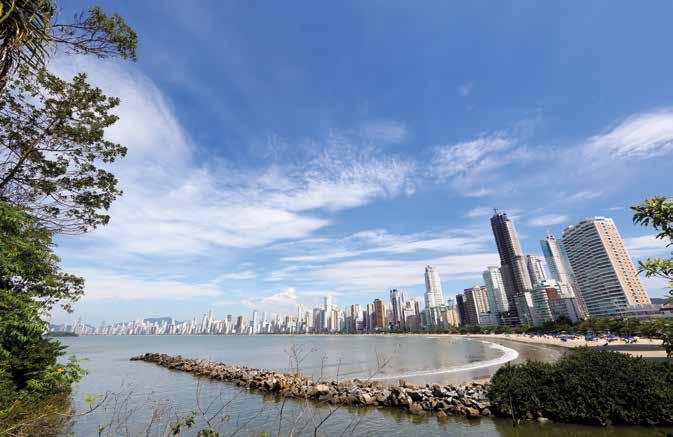
The State of Santa Catarina is considered one of the main tourist destinations in Brazil for several reasons. Beautiful beaches and natural landscapes, cultural attractions and amusement parks are some of the options in the state, which is located in the south of the country. The seasons in the region are well defined and influences the activities to be chosen by visitors.
In summer, the tip is to visit the state’s beaches. The coastline is 560 kilometers long and has ideal scenarios for the practice of water sports such as surfing, windsurfing, kitesurfing and stand up paddle. Santa Catarina also offers tours that can involve snow and even whale watching, so it is a must-see destination for anyone visiting Brazil.
One of the great gateways for tourists arriving in Brazil, Florianópolis is known for its many beaches, from the most popular ones such as Jurerê, Jurerê In -
ternacional, Joaquina and Ingleses, to the more private ones such as Praia do Forte, Lagoinha, Mozambique, Brava, Ribeirão da Ilha, Shipwrecked and Armação.
Florianópolis also offers many historical attractions, including the sites of the original Azorean settlers, Lagoa da Conceição and Santo Antônio de Lisboa, which are worth a visit. Throughout the year, there are also several events in the city that deserve to be highlighted for their peculiarity, economic relevance and consistency, such as the National Oyster Festival, for example.
The Hercílio Luz Bridge is the most famous symbol of the capital and is worth a stop at its viewpoint, located at the head of the bridge, from where you can have one of the most beautiful panoramic views of downtown Florianópolis.
Other must-visit points are the Florianópolis Public Market, the Morro da Cruz observatory, the Dunes in Joaquina Beach, and the natural pools of Barra da Lagoa.

CAPITAL: FLORIANÓPOLIS
OFFICIAL WEBSITE: WWW.SETUR.SC.GOV.BR

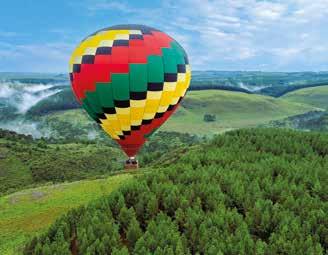
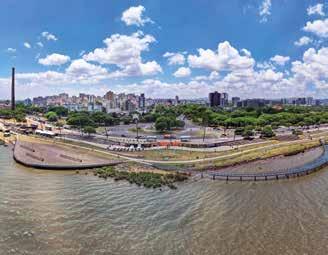
Rio Grande do Sul offers excellent hotel infrastructure and several options of restaurants that carries the characteristics of the local gastronomy. Mixing urban and natural landscapes, the state has lots of cultural activities, adventure sports options and beautiful landscapes to be observed. With temperatures below the country’s
CAPITAL: PORTO ALEGRE
OFFICIAL WEBSITE : WWW.SETUR.RS.GOV.BR
average, it is in Rio Grande do Sul that tourists can find a good place to enjoy the cold weather. For this reason, mate, barbecue and wine consumption are so popular in the state.
However, that’s not all. Rio Grande do Sul also offers several options of rustic and urban beaches, such as Praia Grande, Praia da Cal and Arroio do Sal, among others. In addition, the destination is equipped with port and good air infrastructure, making the arrival at the state really easy.
The capital Porto Alegre is one of the most important in the country, full of culture, rich architecture and cutting-edge cuisine, in addition to a harmonious and complementary contrast between the natural beauties of its resorts and the great buildings of the cosmopolitan city.
Affectionately called POA, the capital has one of the most beautiful streets in the world, the Gonçalo de Carvalho street, located in the Independência neighborhood. Completely wooded, the scenery is magical and guarantees a nice breathe in the middle of the stone jungle.
Your itinerary around the city should include Praça da Matriz, Usina do Gasómetro and Parque da Redenção. The Public Market, with more than 146 years of existence, is also a must, as it brings together all the ‘gaucho’ tradition. For those looking for outdoor walks and contact with nature, the Guaíba River, Parque Marinha Brasil, Moinhos de Vento, Parque Redenção and Farroupilha are the perfect options.Omaximus aucit; et dem pula di sit quam noc, quidi, occiptere et ina, nonfica verum misquoste alarei publibuntiam facescid nuntiam, quam des resis, ne tem nonsultum re, sinatus nonocus, untis.







Associação Brasileira de Agências de Viagem (Brazilian Association of Travel Agencies) (55-11) 3155-3077 www.abav.com.br
Associação Brasileira de Agências de Viagens de São Paulo (Abav-SP) / Associação das Agências de Viagens do Interior do Estado de São Paulo (Aviesp) (Brazilian Association of Travel Agencies of São Paulo (Abav-SP) / Association of Travel Agencies of the Interior of the State of São Paulo (Aviesp)) (55-11) 2626-1905 www.abavsp-aviesp.com.br
Associação Brasileira de Empresas de Eventos (Brazilian Association of Event Companies) (55-21) 96621-0680 www.abeoc.org.br
Associação Brasileira da Indústria de Hotéis (Brazilian Hotel Industry Association) (55-61) 98612-6197 • (55-61) 3326-1177 www.abih.com.br
Asociación Brasileña de Resorts (55-11) 3884-4300 www.aber-resortsbrasil.com.br
Associação Brasileira de Agências de Viagens Corporativas (Brazilian Association of Corporate Travel Agencies) (55-11) 3382-1359 www.abracorp.org.br
Associação Latino Americana de Gestão de Eventos e Viagens Corporativas (Latin American Association of Event Management and Corporate Travel) (55-11) 94990-0153 www.alagev.org
Associação das Agências de Viagens de Ribeirão Preto e Região (Association of Travel Agencies of Ribeirão Preto and Region) (55-16) 3911-7606 / (55-16) 98152-9677 www.avirrp.com.br
Brazilian Educational & Language Travel Association (55-11) 99323.4794 www.belta.org.br
Associação Brasileira de Turismo Receptivo Internacional (Brazilian Association of DMCs) (55-21) 2256-6897 www.bito.com.br
Associação Brasileira das Operadoras de Turismo (Brazilian Association of Tour Operators) (55-11) 3122-9595 www.braztoa.com.br
Associação Brasileira de Cruzeiros Marítimos (Brazilian Cruise Lines Association) (55-11) 3337-5000 www.abremar.com.br
Confederação Nacional do Comércio de Bens, Serviços e Turismo (National Confederation of Trade in Goods, Services and Tourism) (55-61) 3329-9500 / (55-21) 3804-9200 www.cnc.com.br
FBHA
Federação Brasileira de Hospedagem e Alimentação (Brazilian Federation of Accommodation and Food) (55-61) 3226-6556 www.fbha.com.br
Fórum de Operadores Hoteleiros do Brasil (Brazilian Hotel Operators Forum) (55-11) 3884-3654 www.fohb.com.br
Câmara de Comércio de Turismo LGBT do Brasil (Brazilian LGBT Tourism Chamber of Commerce) (55-11) 3151-2155 www.camaralgbt.com.br
União Nacional de CVBx e Entidades de Destinos (National Union of CVBx and Destination Entities) (55-11) 3736-0613 www.unedestinos.com.br
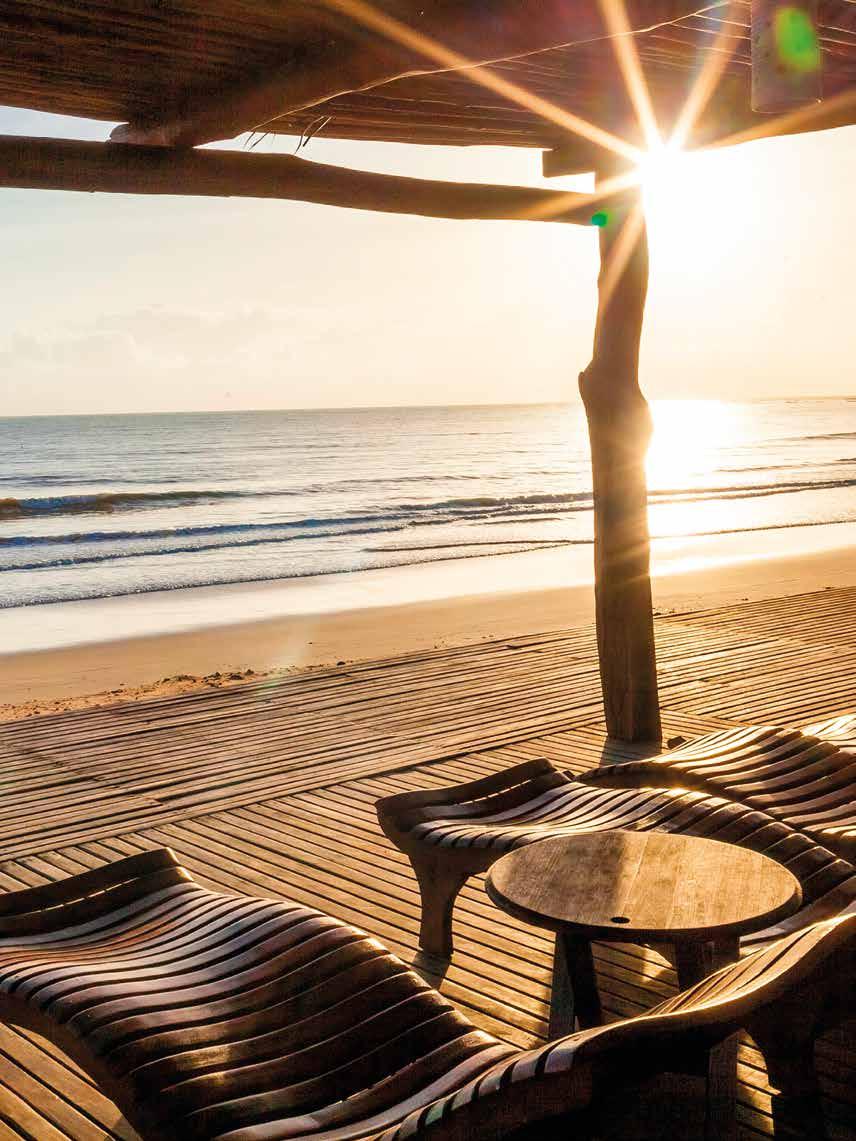

Flying directly to 12 destinations:
Rio de Janeiro · São Paulo · Salvador
Recife · Fortaleza · Brasília
Belo Horizonte · Maceió · Belém
Natal · Florianópolis · Manaus